In the heart of the Indian Ocean, Mauritius isn’t just a tropical paradise for sun-seekers; it’s a veritable avian wonderland. With approximately 120 bird species flitting about, this island is a birdwatcher’s dream come true.
From the Echo Parakeet to the elusive Pink Pigeon, Mauritius is home to a unique blend of endemic species that make even the most seasoned ornithologists flap with excitement.
Imagine a place where the air is filled with the melodies of the Mauritius Kestrel and the Mauritius Bulbul, each note a reminder of nature’s incredible diversity.
But don’t let the island’s serene beauty fool you—these birds have stories as colorful as their plumage. With a rich history of survival and adaptation, they offer a fascinating glimpse into the island’s ecological tapestry.
Whether you’re a seasoned birder or just someone who thinks “feathered” is a fashion statement, Mauritius invites you to spread your wings and explore.
1. Mauritius Kestrel
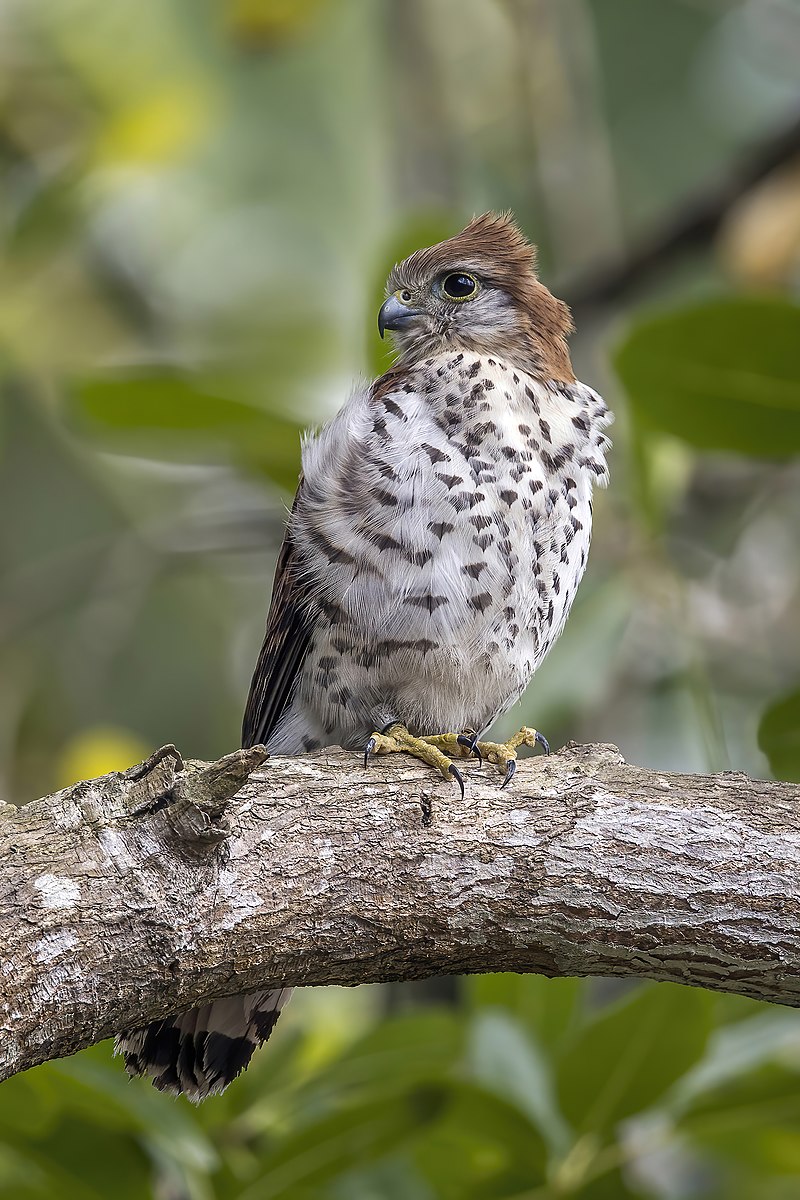
Known as the National Bird of Mauritius since March 2022, the Mauritius Kestrel symbolizes hope after the extinction of the Dodo.
This agile falcon thrives in secondary habitats, favoring rainforest areas. With a post-rebirth peak of 600, its population has declined to about 350, yet experts are hopeful.
Primarily feeding on Mauritian day geckos, it also hunts lizards and small mammals. This falcon’s unique dark moustache mark distinguishes it from others.
Scientific classification:
| Kingdom | Animalia |
| Phylum | Chordata |
| Class | Aves |
| Order | Falconiformes |
| Family | Falconidae |
| Genus | Falco |
| Species | F. punctatus |
2. Dodo
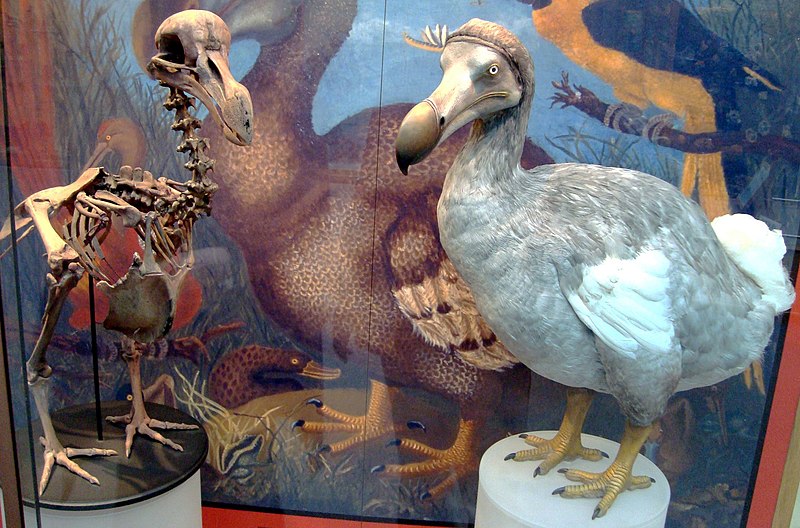
The dodo, a flightless bird native to Mauritius, stood about three feet tall. Its weight ranged from 22 to 40 pounds.
Human activities, including overhunting and habitat destruction by introduced species like pigs and rats, led to the dodo’s extinction in the late 17th century.
The bird remains an icon of human-induced extinction. Mauritians remember the dodo through various cultural symbols, despite its sad tale of ecological disruption.
Scientific classification:
| Kingdom | Animalia |
| Phylum | Chordata |
| Class | Aves |
| Order | Columbiformes |
| Family | Columbidae |
| Subfamily | †Raphinae |
| Genus | †Raphus Brisson, 1760 |
| Species | †R. cucullatus |
Also Featured In: ARK Birds,
3. Echo Parakeet
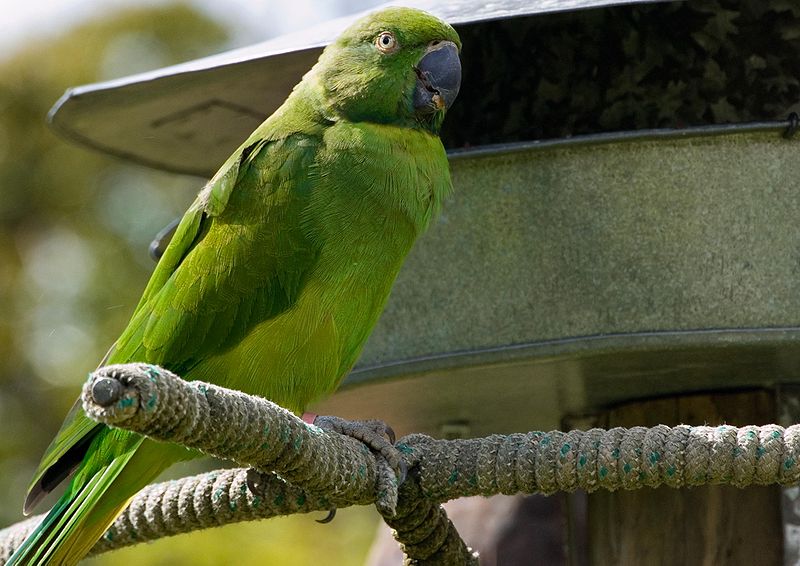
The Echo Parakeet, Psittacula eques, thrives in the lush forests of Mauritius. Once critically endangered, their population now exceeds 800 due to effective conservation strategies.
These emerald-green parrots are endemic to the island’s Black River Gorges area. Males sport a striking black neck collar and a red upper beak, distinct from females’ all-black beak.
Feeding on flowers, leaves, and fruits, they illustrate successful species recovery endeavors.
Scientific classification:
| Kingdom | Animalia |
| Phylum | Chordata |
| Class | Aves |
| Order | Psittaciformes |
| Family | Psittaculidae |
| Genus | Psittacula |
| Species | P. eques |
4. Pink Pigeon
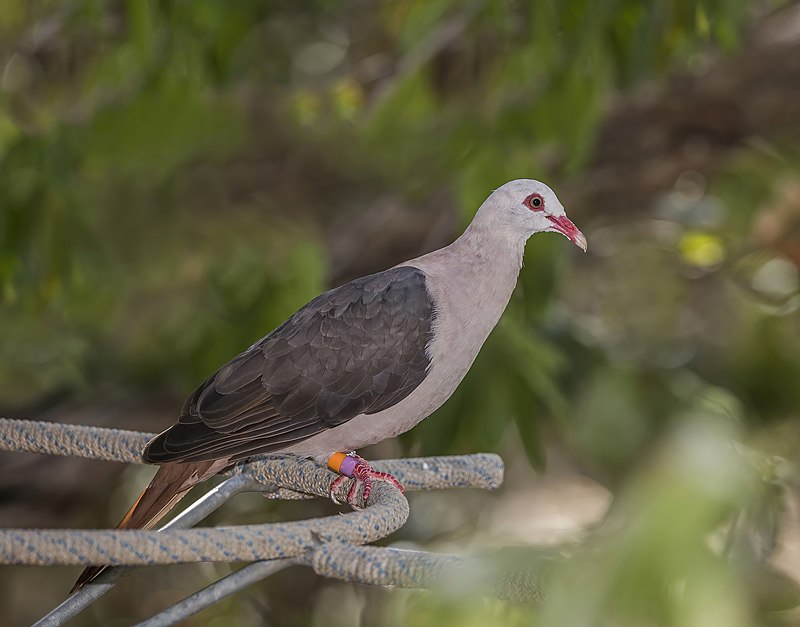
The Pink Pigeon, Nesoenas mayeri, thrives as an endemic bird in Mauritius. Its pale pink plumage and brown wings make it easily recognizable.
Only ten individuals remained in the 1980s, but thanks to conservation efforts, the population rebounded to about 500. These pigeons predominantly consume fruits and leaves.
They still face threats from habitat destruction and invasive species. Conservation efforts remain crucial for their continued survival.
Scientific classification:
| Kingdom | Animalia |
| Phylum | Chordata |
| Class | Aves |
| Order | Columbiformes |
| Family | Columbidae |
| Genus | Nesoenas |
| Species | N. mayeri |
5. Mauritius Fody
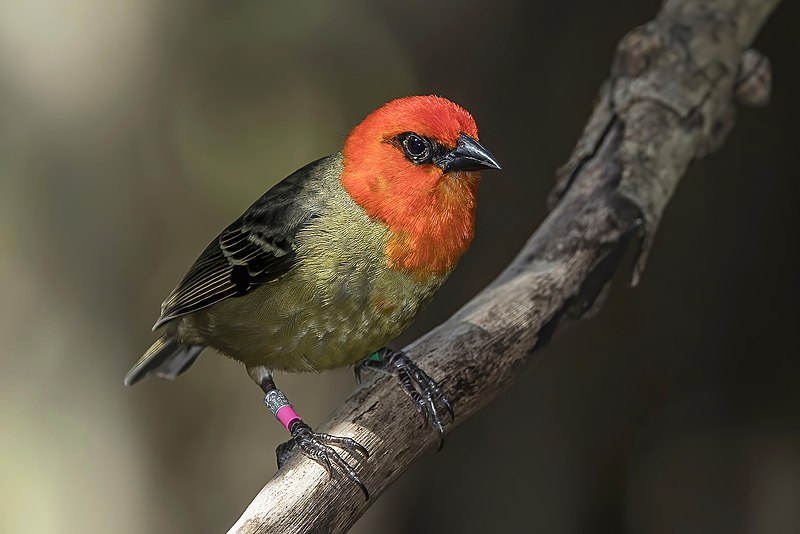
The Mauritius Fody, an endemic songbird, embodies conservation success with its population reaching 500.
Once abundant in Mauritius’s jungles, it now thrives in Île aux Aigrettes and Black River Gorges. Males flaunt red plumage and an orange rump patch during breeding, contrasting with the females’ olive-brown hues.
The fody’s diet includes insects, fruits, and nectar, highlighting its integral role in the island’s ecology.
Scientific classification:
| Kingdom | Animalia |
| Phylum | Chordata |
| Class | Aves |
| Order | Passeriformes |
| Family | Ploceidae |
| Genus | Foudia |
| Species | F. rubra |
6. Mauritius Olive White-Eye
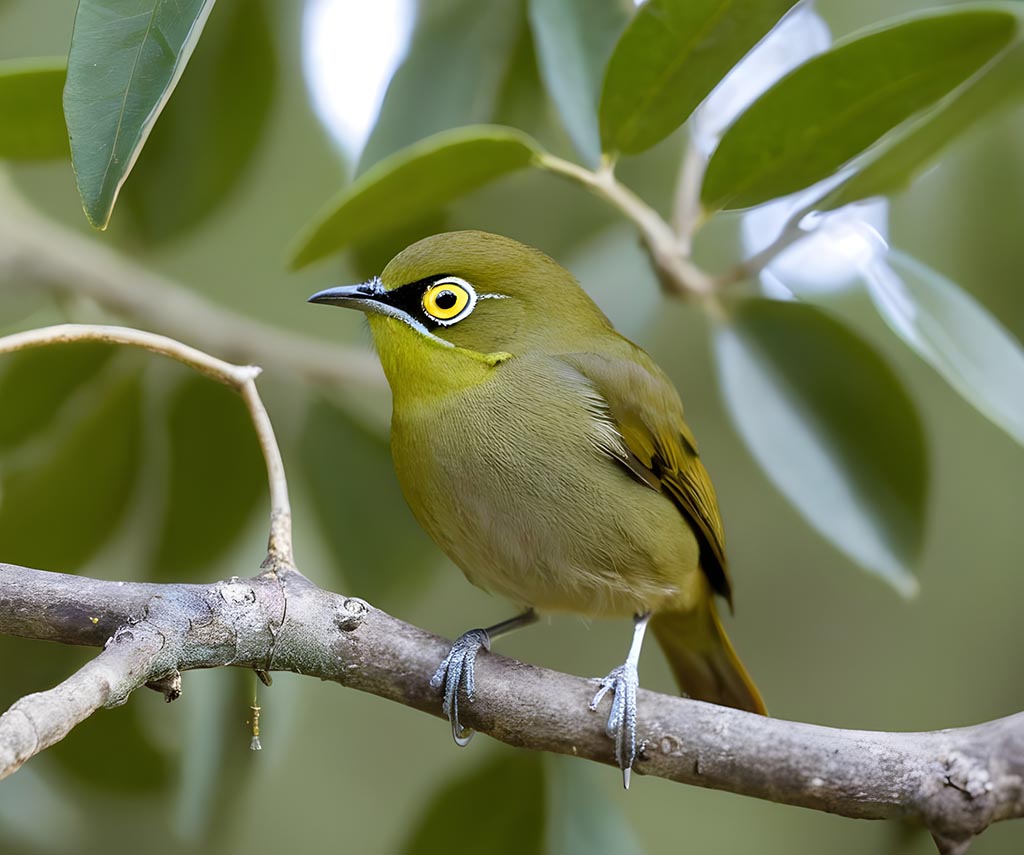
The Mauritius Olive White Eye ranks among the rarest birds in Mauritius. Fewer than 150 pairs exist, mainly in Black River Gorges National Park.
It’s a small bird with a dull olive-green upper body and distinct bright white eye rings. This bird’s size averages 10 cm, making it the smallest Mauritian songbird.
Habitat loss and invasive species like rats threaten its survival, highlighting the urgency of conservation efforts.
Scientific classification:
| Kingdom | Animalia |
| Phylum | Chordata |
| Class | Aves |
| Order | Passeriformes |
| Family | Zosteropidae |
| Genus | Zosterops |
| Species | Z. chloronothos |
7. Bulbul
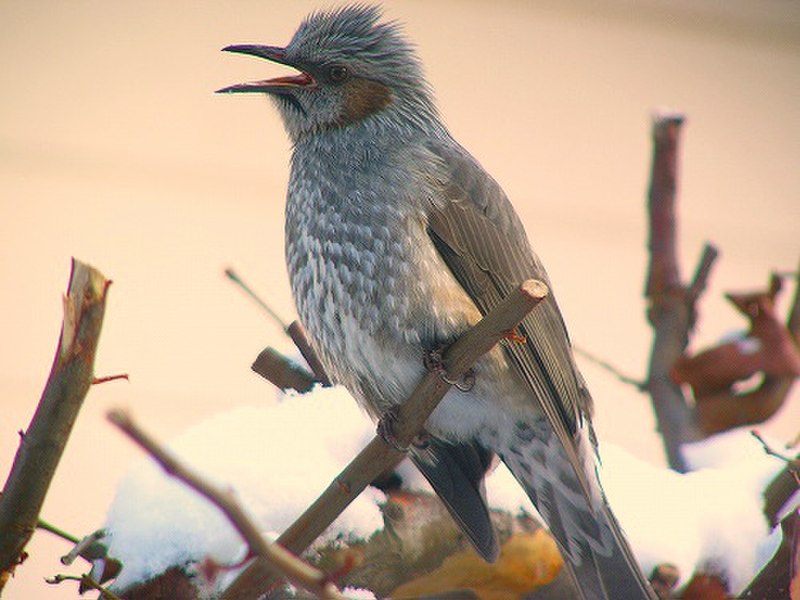
Bulbuls, medium-sized songbirds from the Pycnonotidae family, enchant birdwatchers in Mauritius. Found in varied habitats, these birds are crucial seed dispersers due to their fruit-based diet.
The islands’ bulbuls often feature slender bodies, long tails, and slightly hooked bills.
Vocal and popular as cage birds, they face threats from habitat loss. Species-specific conservation efforts help preserve their role in the islands’ ecosystems.
Scientific classification:
| Kingdom | Animalia |
| Phylum | Chordata |
| Class | Aves |
| Order | Passeriformes |
| Parvorder | Sylviida |
| Family | Pycnonotidae Gray, GR, 1840 |
8. Red-Whiskered Bulbul
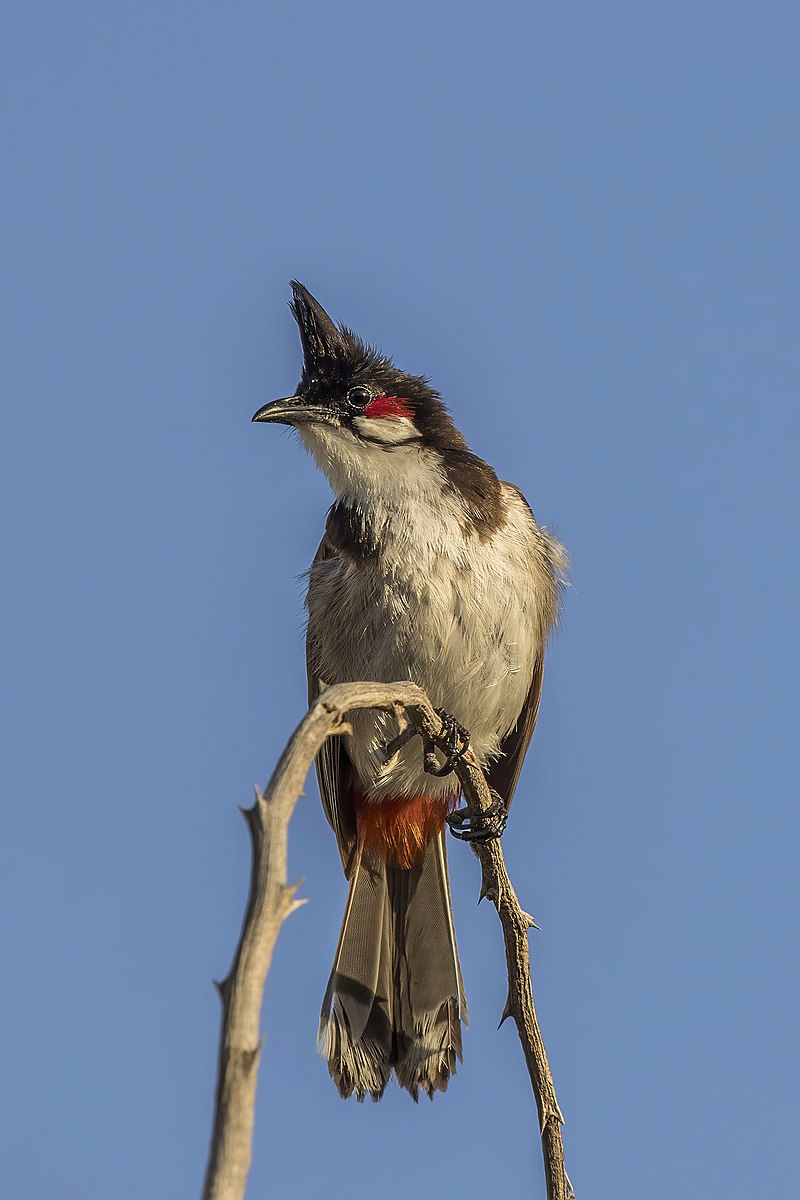
The Red Whiskered Bulbul stands out with its black crest, white cheeks, and red patches. Native to southern Asia, it thrives in urban and forested areas of Mauritius.
Measuring about 20 cm, its diet includes fruits, insects, and nectar. However, as an introduced species, it contributes to competition with native birds for resources.
Despite its charm, its presence signifies ecological challenges in Mauritius.
Scientific classification:
| Kingdom | Animalia |
| Phylum | Chordata |
| Class | Aves |
| Order | Passeriformes |
| Family | Pycnonotidae |
| Genus | Pycnonotus |
| Species | P. jocosus |
9. Mauritius Blue Pigeon
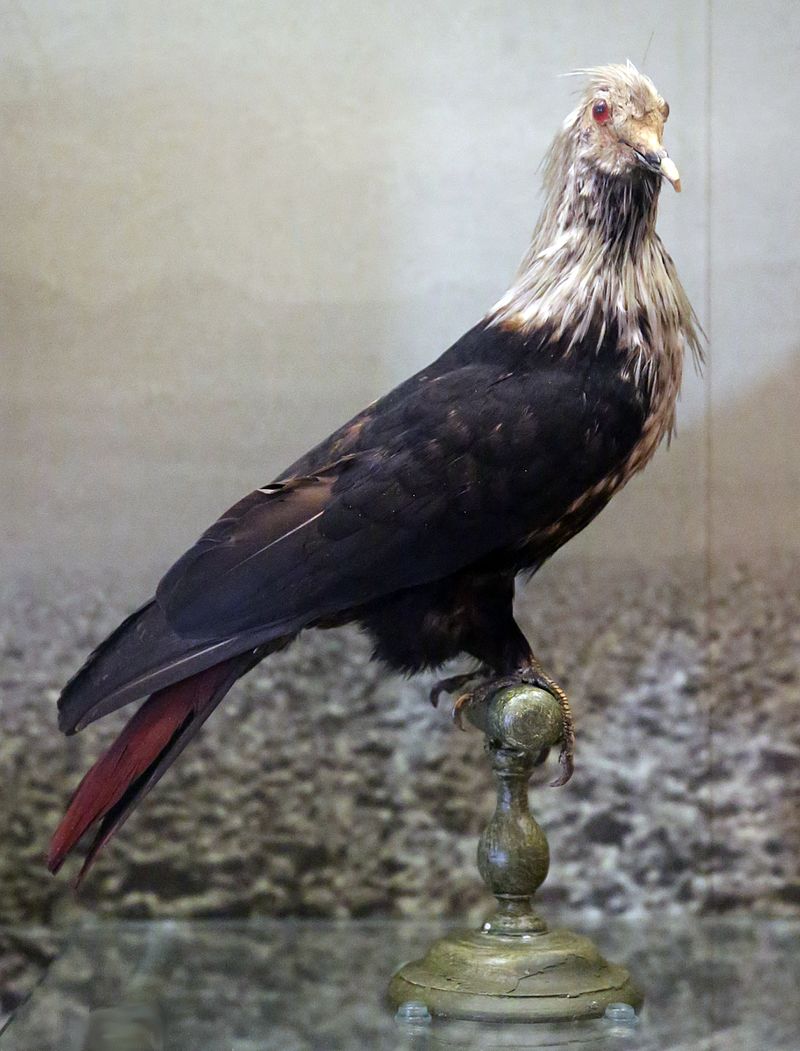
The Mauritius Blue Pigeon, extinct since 1830, belonged to Mauritius. It measured about 30 cm long and had blue plumage, white head hackles, and a red tail.
Feasting on fruits, nuts, and mollusks, this striking pigeon became extinct due to deforestation and hunting by introduced species.
Resembling the Dutch flag, this pigeon was also known as Pigeon Hollandais, highlighting its unique color combination and historical significance.
Scientific classification:
| Kingdom | Animalia |
| Phylum | Chordata |
| Class | Aves |
| Order | Columbiformes |
| Family | Columbidae |
| Genus | Alectroenas |
| Species | †A. nitidissimus |
10. Mascarene Paradise Flycatcher
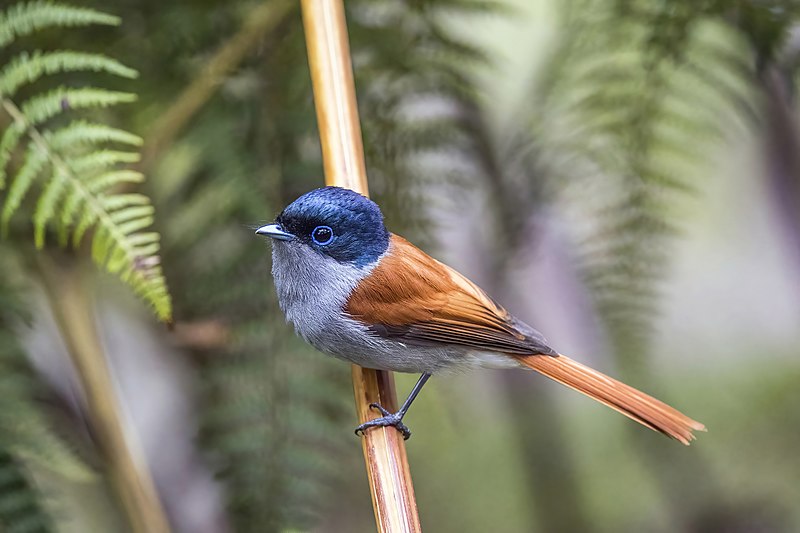
The Mascarene Paradise Flycatcher thrives on the Mascarene Islands. Endemic to Mauritius and Réunion, this bird belongs to the Monarchidae family.
Males display a striking appearance with black heads and chestnut upperparts, while their bluish bills catch the eye.
Native evergreen forests shelter these birds, where insects form their primary diet. Nesting occurs using moss and lichen material, though habitat loss poses serious threats to
Scientific classification:
| Kingdom | Animalia |
| Phylum | Chordata |
| Class | Aves |
| Order | Passeriformes |
| Family | Monarchidae |
| Genus | Terpsiphone |
| Species | T. bourbonnensis |
11. Mauritius Cuckooshrike
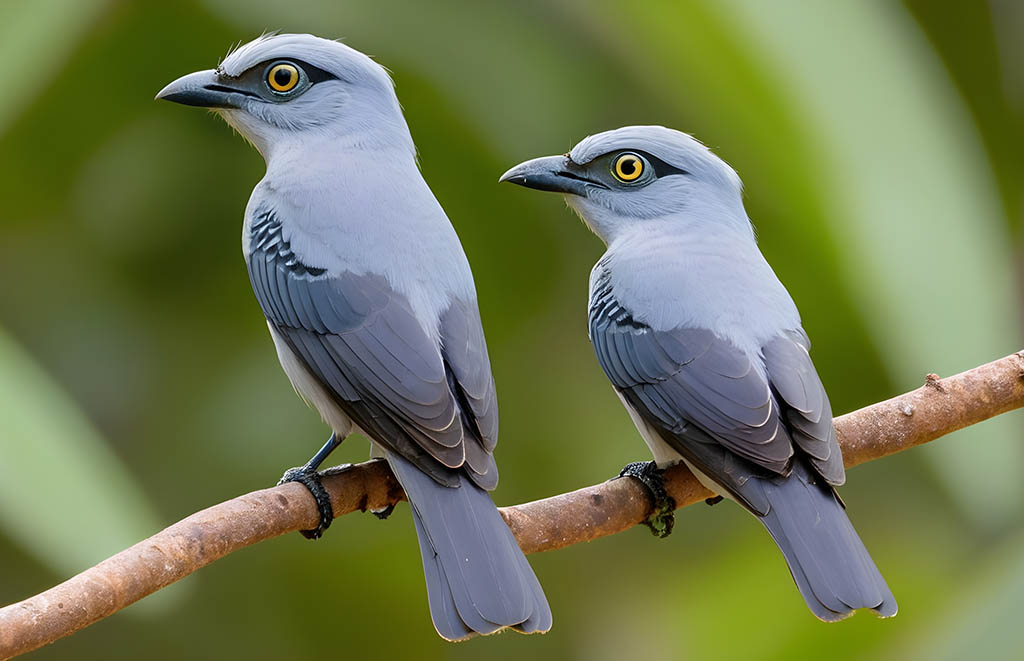
The Mauritius Cuckooshrike is a rare bird endemic to Mauritius. It stands out with striking black and white plumage and distinctive yellow eyes.
Measuring about 25 cm, this medium-sized bird thrives in the island’s forests. It primarily feeds on insects and fruits.
Drastic population decline occurred due to habitat loss and invasive species. Conservation efforts focus on habitat restoration and protection to ensure the species’ survival. Though vulnerable, these initiatives represent hope for the Cuckooshrike.
Scientific classification:
| Kingdom | Animalia |
| Phylum | Chordata |
| Class | Aves |
| Order | Passeriformes |
| Family | Campephagidae |
| Genus | Lalage |
| Species | L. typica |
12. Village Weaver
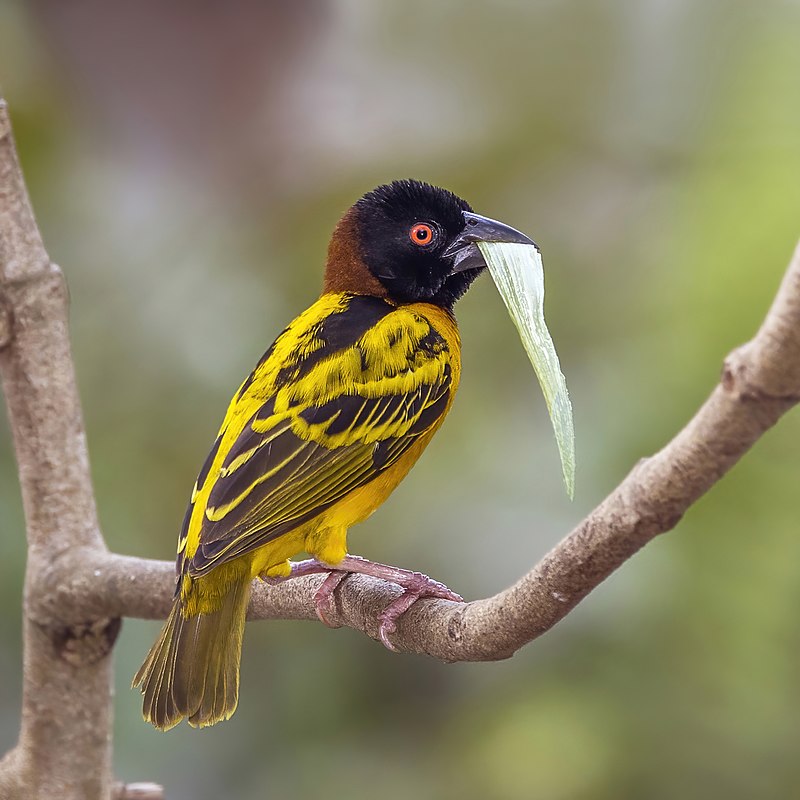
The Village Weaver, also known as the spotted-backed or black-headed weaver, is a social bird native to sub-Saharan Africa, with populations in Portugal and the Caribbean.
They measure 15–17 cm, featuring a strong conical bill and dark reddish eyes. Males display bright colors during breeding, while females and non-breeding males are less colorful.
Skillful nest builders, these weavers construct intricate nests from grass and leaves within large colonies.
Their diet mainly consists of seeds and grains, with insects added for their young. Classified as “Least Concern,” they thrive in diverse environments like woodlands and human areas.
Scientific classification:
| Kingdom | Animalia |
| Phylum | Chordata |
| Class | Aves |
| Order | Passeriformes |
| Family | Ploceidae |
| Genus | Ploceus |
| Species | P. cucullatus |
13. White-Tailed Tropicbird
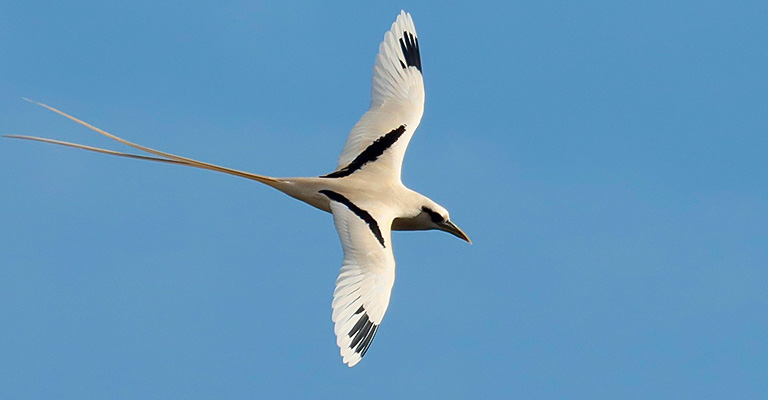
The White-Tailed Tropicbird, Phaethon lepturus, inhabits tropical and subtropical regions including Mauritius.
This slender seabird measures 71-80 cm in length, its long central tail feathers extending its appearance.
Predominantly white with black wing markings, it has a bright yellow bill. Breeding on rocky cliffs, it lays a single egg.
Feeding involves diving up to 20 meters deep for fish and squid. Conservation efforts aim to counteract habitat loss impacts.
Scientific classification:
| Kingdom | Animalia |
| Phylum | Chordata |
| Class | Aves |
| Order | Phaethontiformes |
| Family | Phaethontidae |
| Genus | Phaethon |
| Species | P. lepturus |
Also Featured In: Birds You’ll Find in the Sea, Birds of Kauai, Hawaii
14. Mascarene Swiftlet
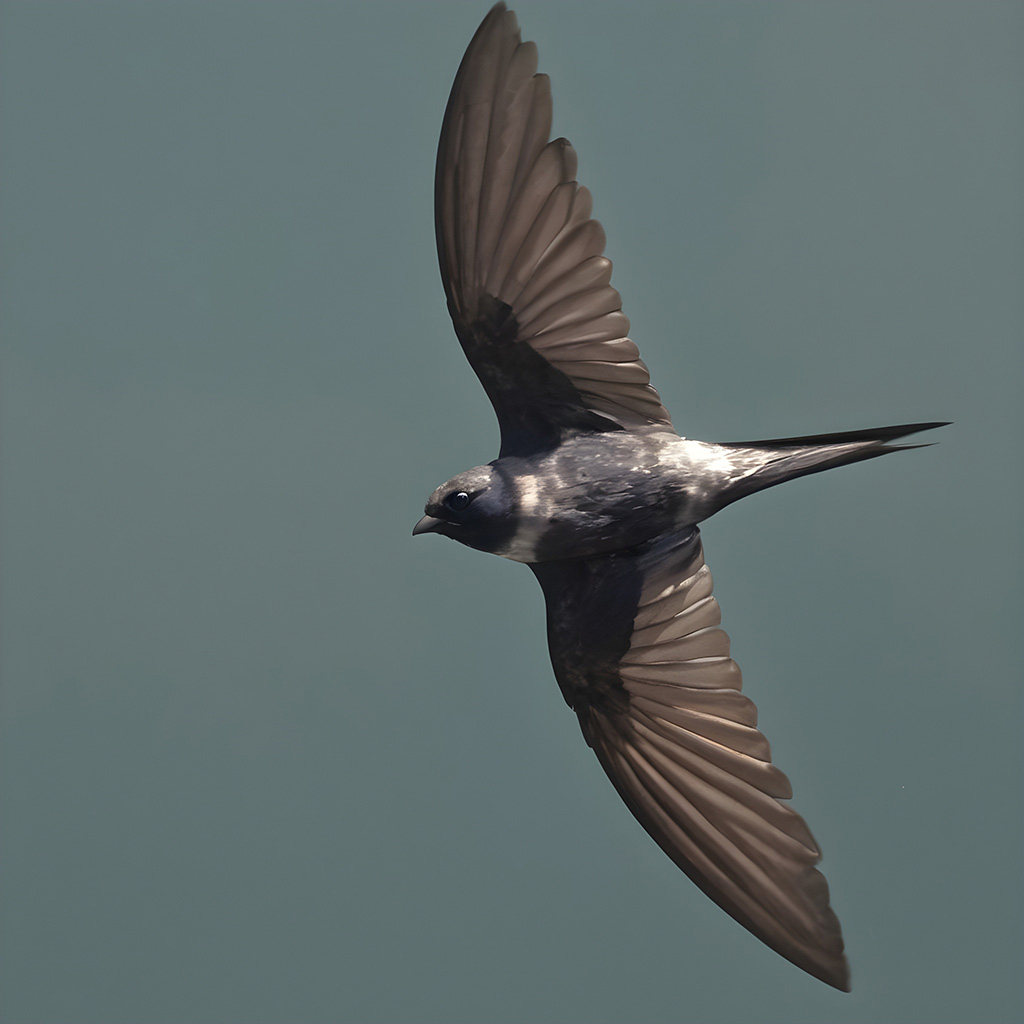
The Mascarene Swiftlet, measuring 12-14 cm, showcases agile flight with long wings. Endemic to Mauritius and Réunion, it has dark brown plumage with a white throat.
These birds nest in colonies using saliva to form cup-shaped nests. Habitat loss and predation threaten their survival, necessitating conservation efforts. They primarily feed on insects in mid-air.
Scientific classification:
| Kingdom | Animalia |
| Phylum | Chordata |
| Class | Aves |
| Order | Apodiformes |
| Family | Apodidae |
| Genus | Aerodramus |
| Species | A. francicus |
15. Rodrigues Warbler
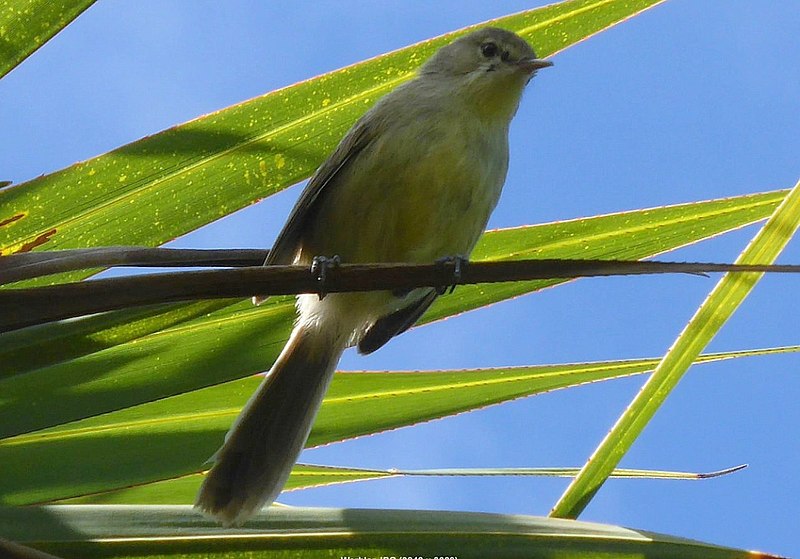
The Rodrigues Warbler, Acrocephalus rodericanus, inhabits the island of Rodrigues in the Indian Ocean. Measuring about 15 cm, this critically endangered bird features a long tail and unique song.
Its population plummeted due to habitat destruction and invasive species. Conservation initiatives aim to protect its remaining habitat.
It’s essential for maintaining Rodrigues’s biodiversity. Active efforts support the warbler’s survival amid ongoing ecological challenges.
Scientific classification:
| Kingdom | Animalia |
| Phylum | Chordata |
| Class | Aves |
| Order | Passeriformes |
| Family | Acrocephalidae |
| Genus | Acrocephalus |
| Species | A. rodericanus |
16. Red Fody
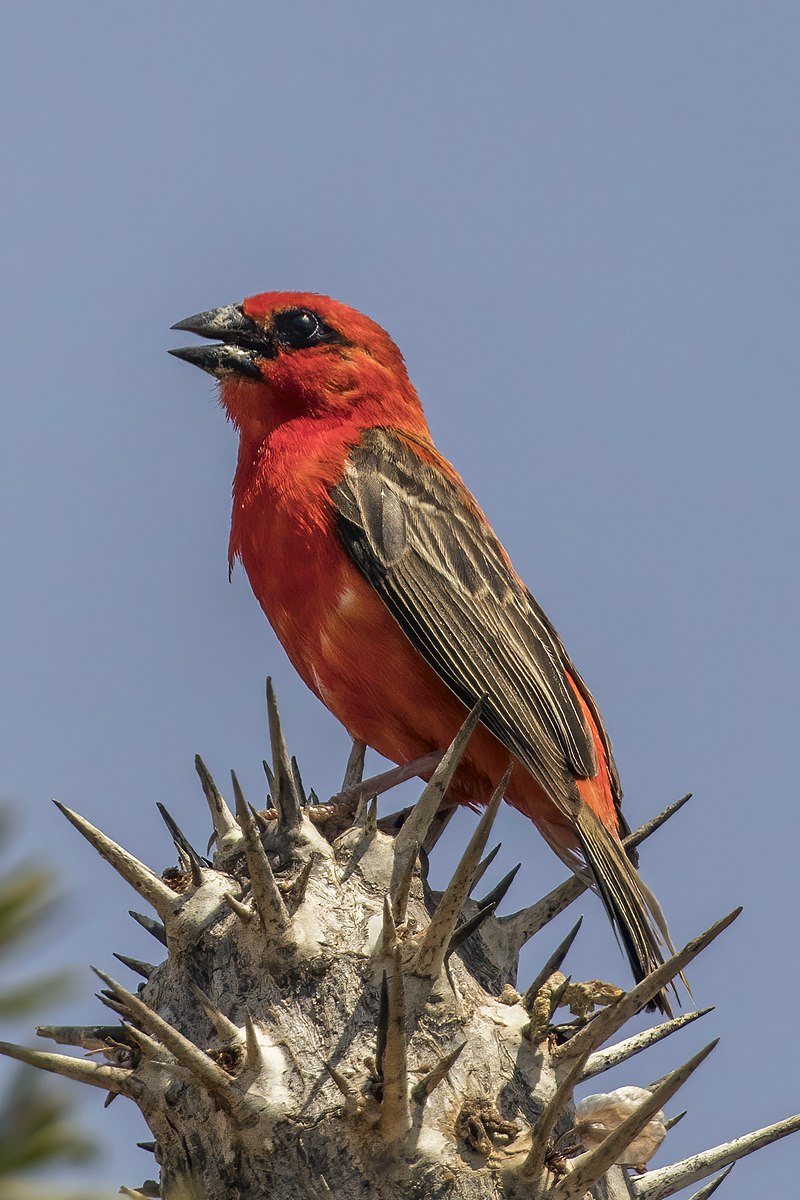
The Red Fody, native to Madagascar but also found in Mauritius, displays scarlet plumage during breeding seasons in males. Females and non-breeding males sport olive-brown feathers.
Measuring about 14 cm and weighing 14-19 grams, they inhabit forest clearings, grasslands, and cultivated areas.
They build intricate nests, laying 2-4 eggs. With an adaptability that enables survival across various environments, the Red Fody competes with native species for resources.
Scientific classification:
| Kingdom | Animalia |
| Phylum | Chordata |
| Class | Aves |
| Order | Passeriformes |
| Family | Ploceidae |
| Genus | Foudia |
| Species | F. madagascariensis |
17. Grey Plover
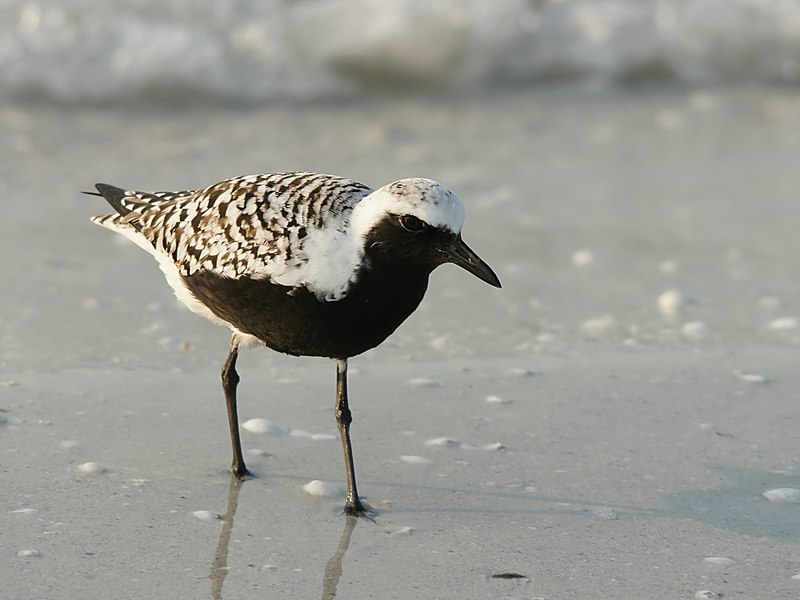
The Grey Plover, known as the Black-bellied Plover, is a globally distributed bird, often seen in coastal areas. It measures approximately 27–30 cm in length, with a noticeable wingspan of 71–83 cm, and weighs between 190–280 g.
This bird boasts a distinctive breeding plumage with a striking black belly contrasting its mottled grey non-breeding feathers.
Adapted to migratory behavior, Grey Plovers travel from Arctic breeding grounds to winter across Europe, Africa, and the Americas. They thrive in sandy and muddy estuaries, feeding primarily on invertebrates.
Scientific classification:
| Kingdom | Animalia |
| Phylum | Chordata |
| Class | Aves |
| Order | Charadriiformes |
| Family | Charadriidae |
| Genus | Pluvialis |
| Species | P. squatarola |
18. Shorebirds
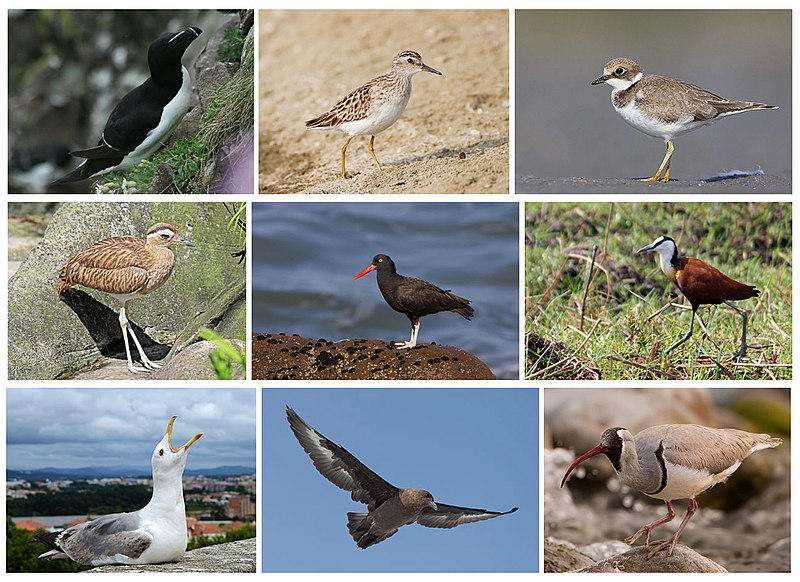
Shorebirds, belonging to the order Charadriiformes, thrive on the coastlines of Mauritius. They include waders like sandpipers and plovers.
Their long legs and specialized bills help them forage for small invertebrates. Many shorebirds migrate vast distances, ensuring access to seasonal food.
Common species in Mauritius include the Whimbrel and Eurasian Curlew. These birds often feed in flocks, exhibiting diverse behaviors to efficiently extract prey.
Scientific classification:
| Kingdom | Animalia |
| Phylum | Chordata |
| Class | Aves |
| Infraclass | Neognathae |
| Clade | Neoaves |
| Clade | Gruimorphae |
| Order | Charadriiformes Huxley, 1867 |
19. Crab-Plover
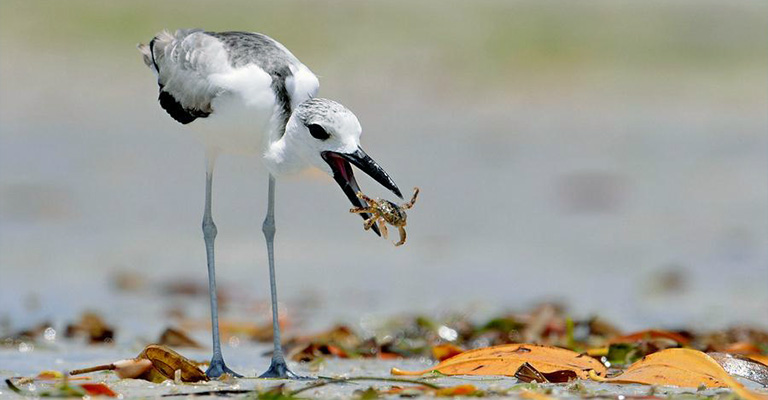
The Crab Plover, Dromas ardeola, stands out among Mauritian birds due to its unique characteristics. It’s distinctive enough to belong to its own family, Dromadidae.
Unlike other waders, it uses ground warmth for egg incubation, a rare behavior. This bird has very long grey legs and resembles a plover.
Found in coastal regions, it primarily inhabits sandy shores and mudflats, feeding on crabs and small invertebrates.
Scientific classification:
| Kingdom | Animalia |
| Phylum | Chordata |
| Class | Aves |
| Order | Charadriiformes |
| Suborder | Lari |
| Family | Dromadidae GR Gray, 1840 |
| Genus | Dromas Paykull, 1805 |
| Species | D. ardeola |
20. Mascarene Martin
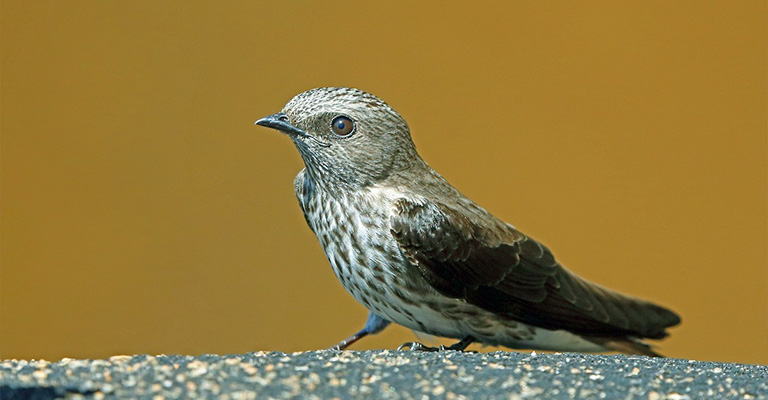
The Mascarene martin, Phedina borbonica, inhabits Madagascar and the Mascarene Islands, including Mauritius.
Its grey-brown underparts transition to white on the throat and lower abdomen, creating a striking contrast with dark grey-brown upperparts.
It nests in colonies, using twigs to create shallow cup-shaped nests in sheltered locations. While flying, it catches insects, showcasing its impressive aerial agility.
Known for distinctive calls, this species adds a unique rhythm to its environment. The Mascarene martin is migratory, with some populations spending winters in East Africa.
Scientific classification:
| Kingdom | Animalia |
| Phylum | Chordata |
| Class | Aves |
| Order | Passeriformes |
| Family | Hirundinidae |
| Genus | Phedina Bonaparte, 1855 |
| Species | P. borbonica |
21. Lesser Kestrel
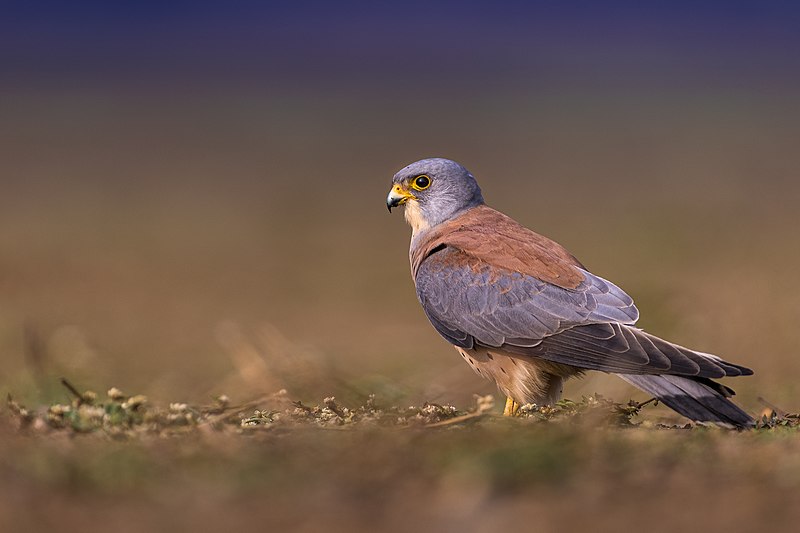
The Lesser Kestrel is a small falcon measuring 27 to 33 cm, with a wingspan of 63 to 72 cm. It breeds in the Palearctic, from the Mediterranean to Central Asia, and migrates to winter in Africa and South Asia.
Favoring open grasslands, cultivated fields, and rocky terrains, it often nests in colonies. Feeding on insects and small vertebrates, the kestrel employs a characteristic hunting technique by pouncing from the air.
Habitat loss and pesticide use have caused significant population declines, prompting conservation concerns.
Scientific classification:
| Kingdom | Animalia |
| Phylum | Chordata |
| Class | Aves |
| Order | Falconiformes |
| Family | Falconidae |
| Genus | Falco |
| Species | F. naumanni |
22. Lesser Vasa Parrot
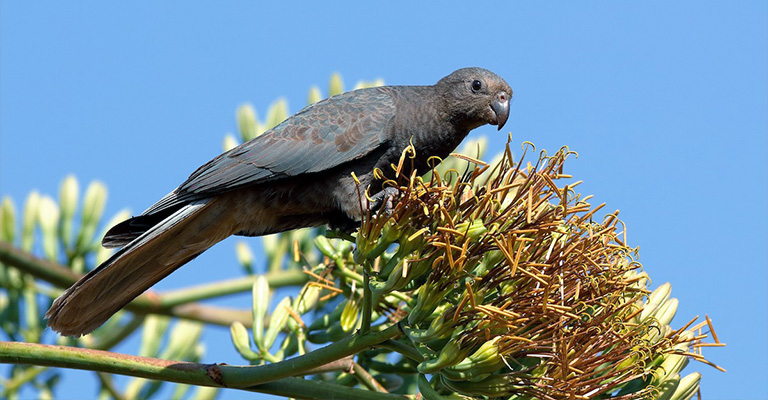
Inhabiting Madagascar, the Lesser Vasa Parrot thrives in mangrove swamps and evergreen forests. This parrot often feeds on seeds, fruits, and blossoms.
Distinguished by dark plumage, it faces conservation concerns due to habitat loss. During courtship, some females show feather loss, appearing yellowish.
Nesting occurs in tree hollows, with rapid incubation lasting 14 to 20 days. Conservation challenges persist due to limited population sizes.
Scientific classification:
| Kingdom | Animalia |
| Phylum | Chordata |
| Class | Aves |
| Order | Psittaciformes |
| Family | Psittrichasiidae |
| Genus | Coracopsis |
| Species | C. nigra |
23. House Crow
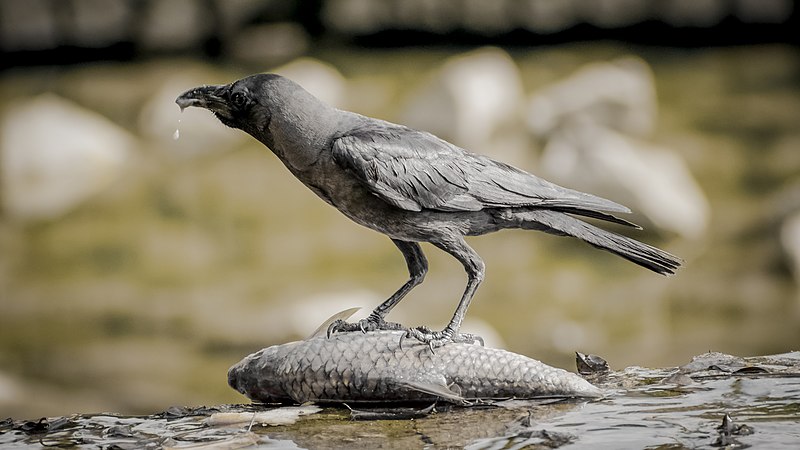
The House Crow, Corvus splendens, belongs to the Corvidae family. It’s native to the Indian subcontinent, measuring about 40 cm.
Adaptable birds, they thrive in urban areas, often residing near human habitation. Glossy black bodies with distinctive grey neck collars characterize them.
Their omnivorous diet includes refuse, small animals, and fruits. Concerns arise about their impact on local ecosystems as these crows spread to regions like East Africa and Europe.
Scientific classification:
| Kingdom | Animalia |
| Phylum | Chordata |
| Class | Aves |
| Order | Passeriformes |
| Family | Corvidae |
| Genus | Corvus |
| Species | C. splendens |
24. Collared Pratincole
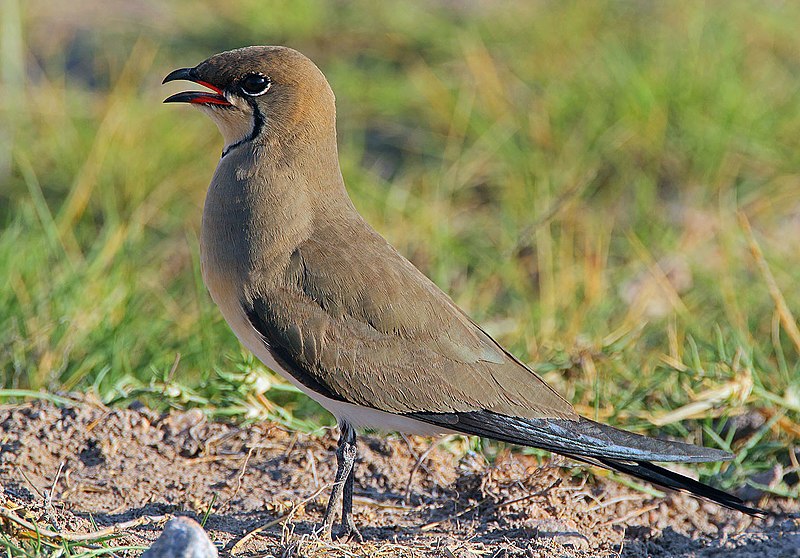
The Collared Pratincole is part of the pratincole family, noted for its short legs and long forked tails. Found across southern Europe, southwest Asia, and Africa, this migratory bird winters in tropical Africa.
Each colony nests by laying 2 to 4 eggs in ground scrapes. Habitat loss and farming intensification contribute to its declining population.
Scientific classification:
| Kingdom | Animalia |
| Phylum | Chordata |
| Class | Aves |
| Order | Charadriiformes |
| Family | Glareolidae |
| Genus | Glareola |
| Species | G. pratincola |
25. Wilson’s Storm Petrel
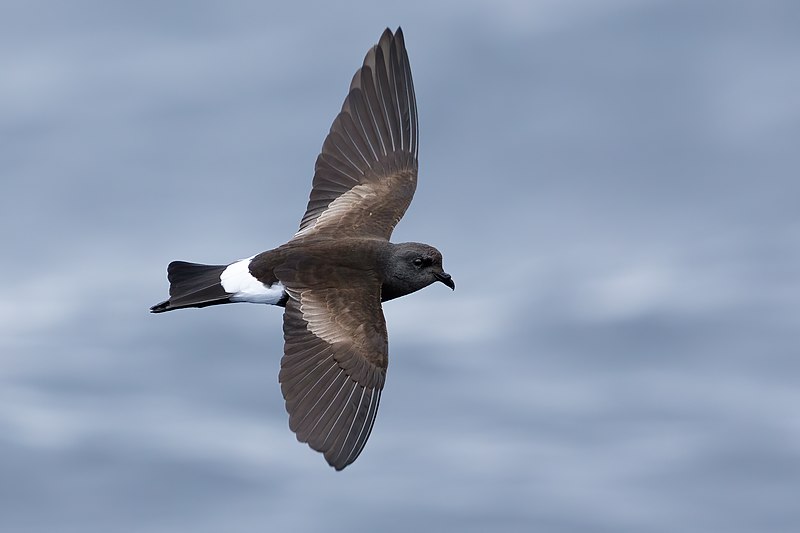
Wilson’s Storm Petrel, measuring 16 to 18.5 cm, features dark brown plumage and a distinctive white rump. It primarily inhabits the Southern Hemisphere, breeding on the Antarctic coast and nearby islands.
This bird displays a unique feeding behavior, pattering its feet on water to catch small crustaceans. With a large population between 8 to 20 million, it’s classified as of least concern by the IUCN.
Scientific classification:
| Kingdom | Animalia |
| Phylum | Chordata |
| Class | Aves |
| Order | Procellariiformes |
| Family | Oceanitidae |
| Genus | Oceanites |
| Species | O. oceanicus |
26. Intermediate Egret
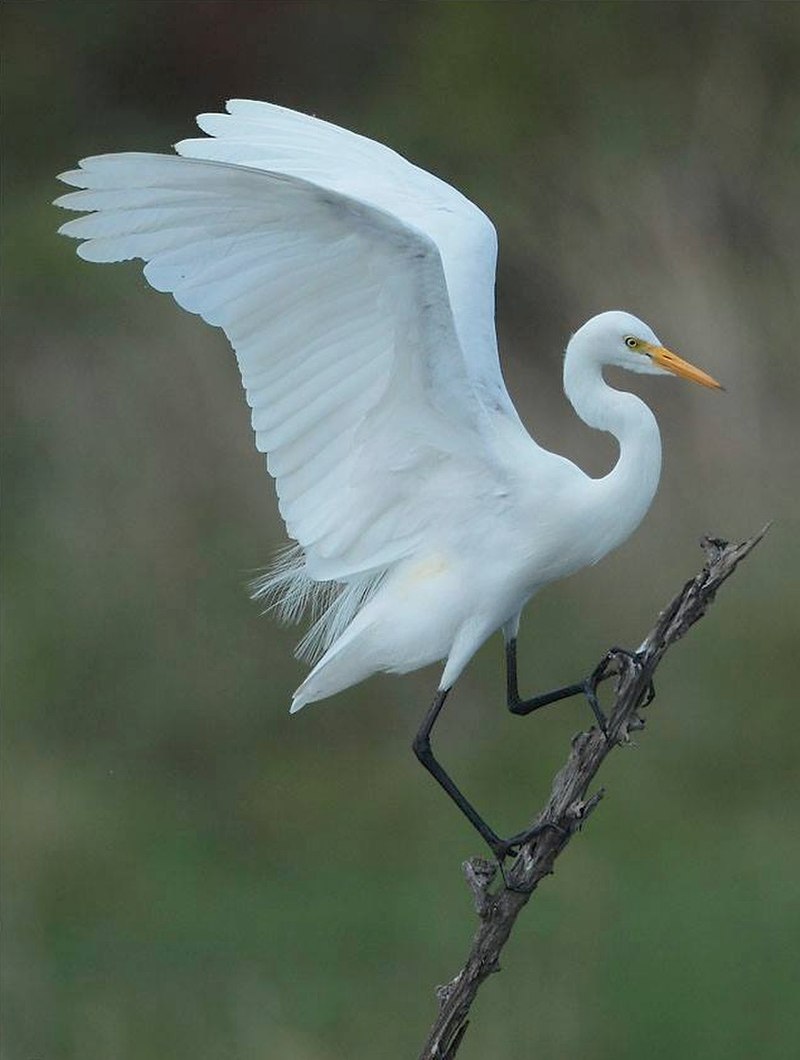
The Intermediate Egret, known as Ardea intermedia, thrives in regions like East Africa, the Indian subcontinent, and Southeast Asia.
It showcases all-white plumage with a yellow bill and dark legs. During breeding, it displays long plumes and adapts well to various habitats, including wetlands and rice fields.
Feeding primarily on fish, frogs, and insects, it often nests with other waterbirds, highlighting its social nature within the avian community.
Scientific classification:
| Kingdom | Animalia |
| Phylum | Chordata |
| Class | Aves |
| Order | Pelecaniformes |
| Family | Ardeidae |
| Genus | Ardea |
| Species | A. intermedia |
Also Featured In: Birds that Commonly Found in Pond , Birds that Live in Sunshine Coast
27. White-Throated Rail
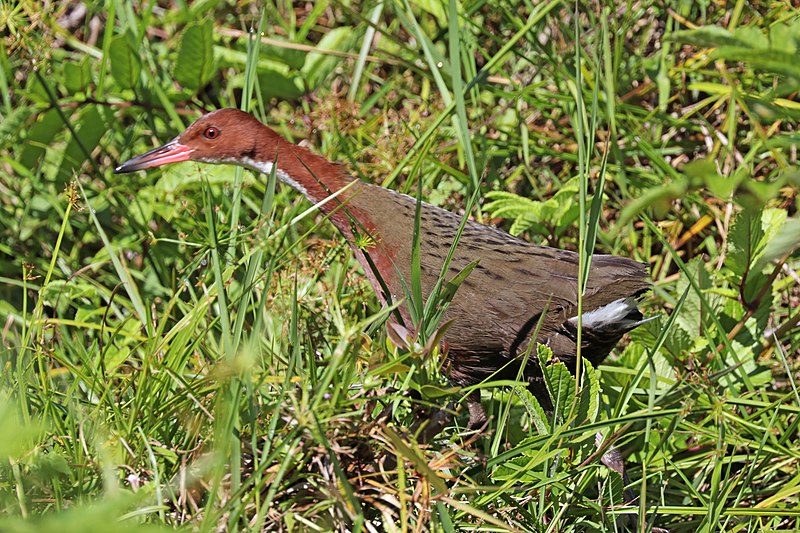
The White-Throated Rail, Cuvier’s rail, resides primarily in Madagascar and nearby islands. This species prefers subtropical and tropical moist lowland forests, thriving among dense vegetation.
A distinct white throat sets it apart, while its dark plumage provides camouflage. Some subspecies exhibit flightlessness due to habitat changes.
Habitat loss and introduced predators pose significant threats, particularly for semi-flightless subspecies, highlighting conservation needs.
Scientific classification:
| Kingdom | Animalia |
| Phylum | Chordata |
| Class | Aves |
| Order | Gruiformes |
| Family | Rallidae |
| Genus | Dryolimnas |
| Species | D. cuvieri |
28. Madagascar Buttonquail
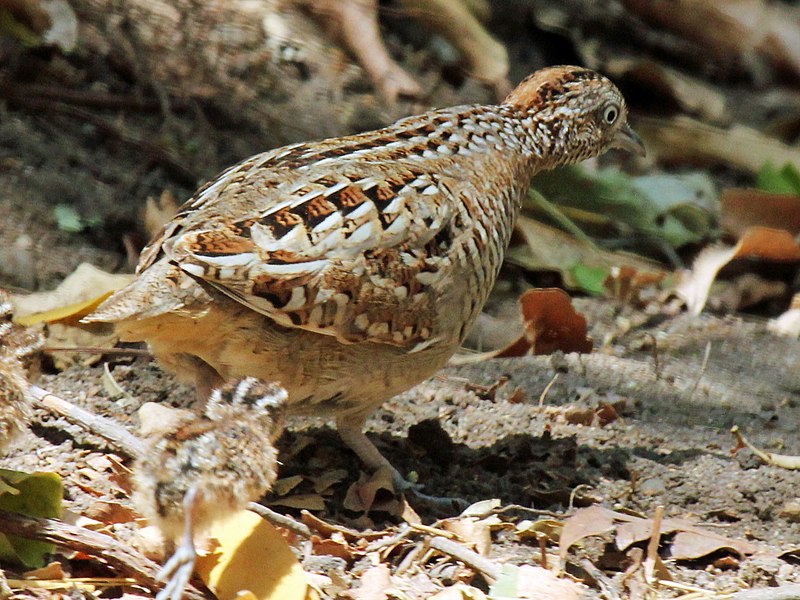
The Madagascar Buttonquail, also known as Turnix nigricollis, thrives on the island of Madagascar. Characterized by its stocky build, it displays cryptic coloration aiding in camouflage.
Males sport a light brown head with distinct black and white streaks. Meanwhile, females possess brighter plumage with striking black chins and throats.
This species occupies grasslands, open woodlands, and cultivated fields. Classified as “least concern” by IUCN, the population remains stable across the island.
Scientific classification:
| Kingdom | Animalia |
| Phylum | Chordata |
| Class | Aves |
| Order | Charadriiformes |
| Family | Turnicidae |
| Genus | Turnix |
| Species | T. nigricollis |
29. Scaly-Breasted Munia
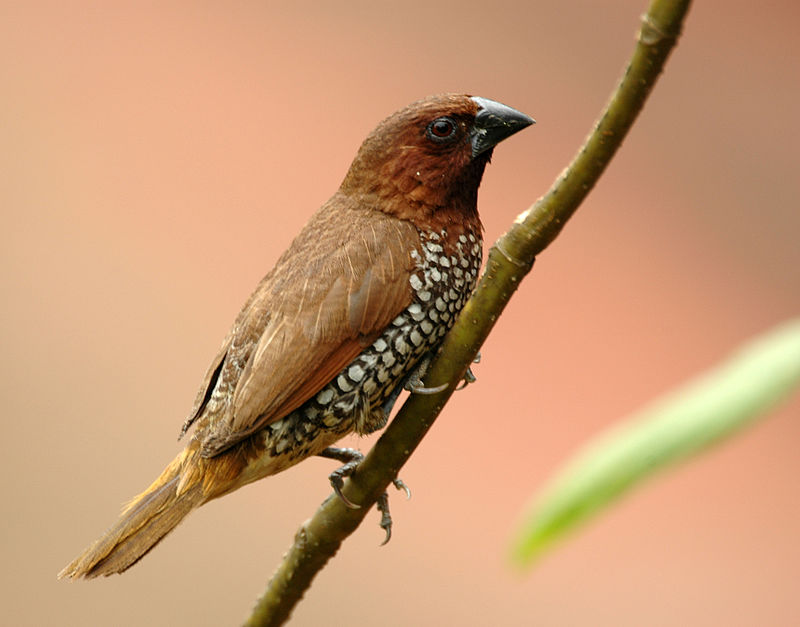
The Scaly Breasted Munia is a small bird in Mauritius, measuring around 11–12 cm. They have dark brown upperparts and distinct white bellies marked with scale-like patterns.
This species, native to tropical Asia, often forms flocks seen foraging on grass seeds and small berries.
Adaptable by nature, Scaly Breasted Munias have established feral populations, including parts of the United States. Their nests, built from grass, typically hold 3-6 eggs per clutch.
Scientific classification:
| Kingdom | Animalia |
| Phylum | Chordata |
| Class | Aves |
| Order | Passeriformes |
| Family | Estrildidae |
| Genus | Lonchura |
| Species | L. punctulata |
Also Featured In: Famous Paintings Birds, Birds that Live in Uttar Pradesh
30. Yellow-Fronted Canary
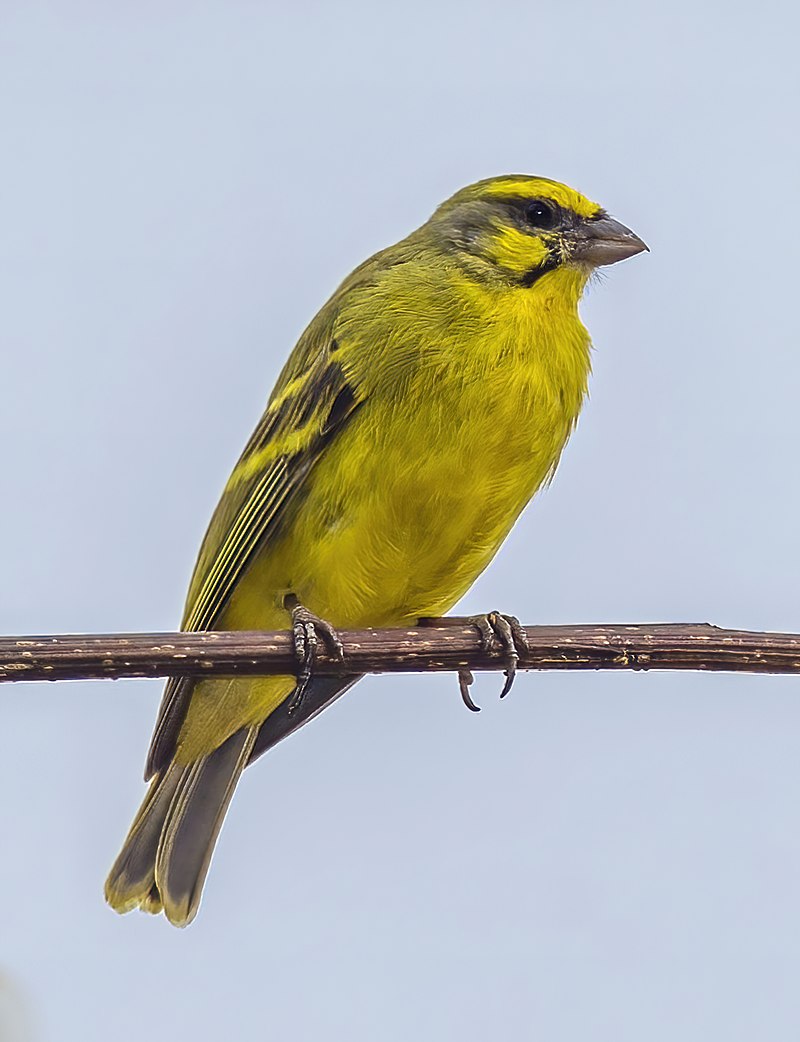
The Yellow Fronted Canary, a small bird native to sub-Saharan Africa, now resides in Mauritius. Measuring about 12 cm, males display yellow faces and bellies.
Females are duller in color. These canaries inhabit gardens and open woodlands, often foraging in flocks for seeds.
They build cup-shaped nests, laying three to four eggs. Known for melodious songs, they maintain stable populations due to wide distribution.
Scientific classification:
| Kingdom | Animalia |
| Phylum | Chordata |
| Class | Aves |
| Order | Passeriformes |
| Family | Fringillidae |
| Subfamily | Carduelinae |
| Genus | Crithagra |
| Species | C. mozambica |
Also Featured In: Most Common Oahu Birds, Hawaii Big Island Birds You Should Know
31. South Polar Skua
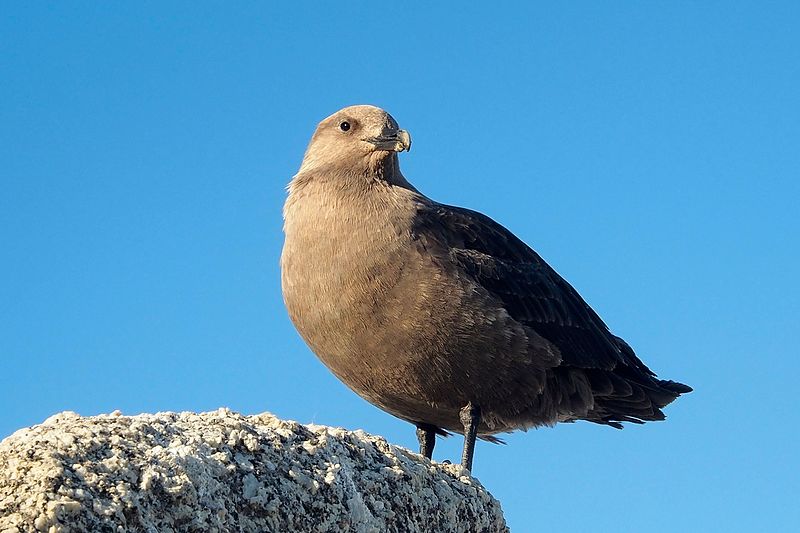
The South Polar Skua (Stercorarius maccormicki) is a prominent seabird predominantly located in Antarctica. Measuring approximately 53 cm in length, it is distinguished by its greyish-brown plumage and lighter underparts.
This species breeds along Antarctic coasts and migrates to the Pacific, Indian, and Atlantic Oceans during winter months.
Renowned for its aggressive feeding habits, it frequently steals fish from other birds. Identification can be difficult due to its resemblance to other skua species.
Scientific classification:
| Kingdom | Animalia |
| Phylum | Chordata |
| Class | Aves |
| Order | Charadriiformes |
| Family | Stercorariidae |
| Genus | Stercorarius |
| Species | S. maccormicki |
Also Featured In: South Shetland Islands Birds You Need To Know,
32. Masked Booby
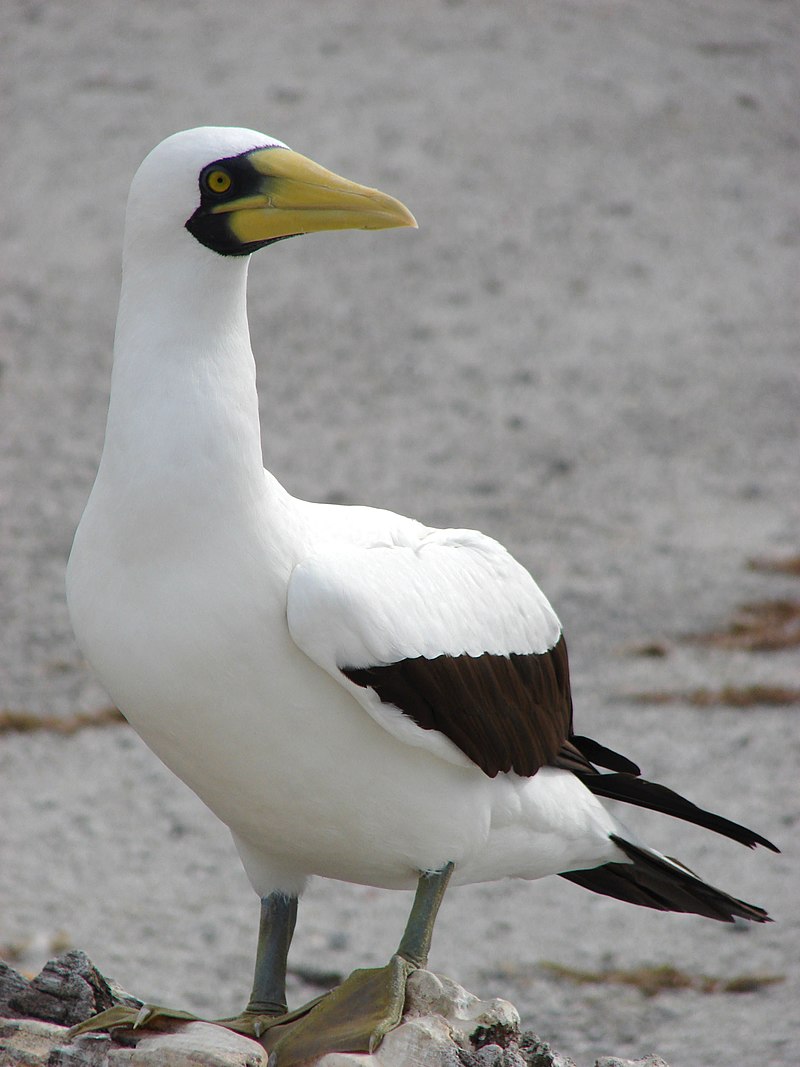
Masked Boobies, Sula dactylatra, inhabit tropical oceans worldwide, recognizable by their white bodies, black wingtips, and dark facial masks over yellow bills.
Measuring 75–85 cm, they are skilled at plunge diving from 30 meters to catch prey like flying fish and squid.
They nest in colonies on isolated islands, laying 1–2 eggs in shallow ground scrapes. Typically silent at sea, they become vocal during the breeding season.
Although they face threats from predators and habitat disturbances, their adaptable nature and wide distribution have led the IUCN to classify them as “Least Concern.”
Scientific classification:
| Kingdom | Animalia |
| Phylum | Chordata |
| Class | Aves |
| Order | Suliformes |
| Family | Sulidae |
| Genus | Sula |
| Species | S. dactylatra |
Also Featured In: Birds that Live in the Ocean , Caribbean Birds
33. Lesser Frigatebird
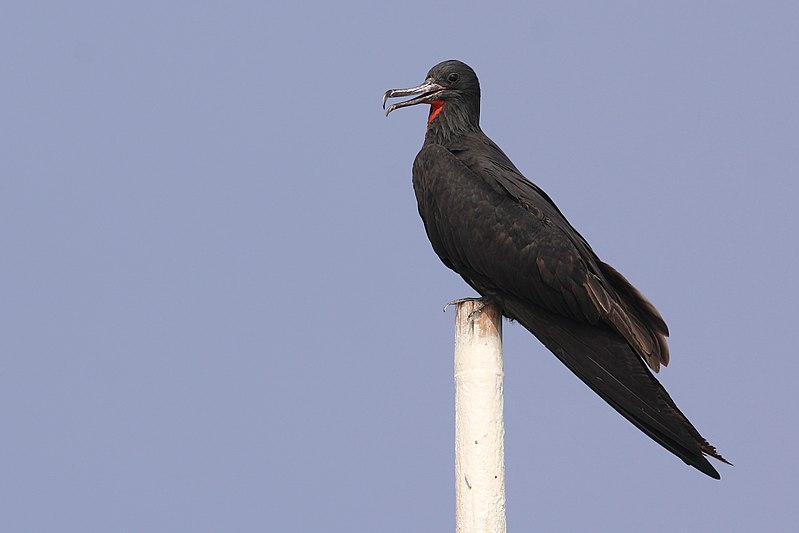
The Lesser Frigatebird, known scientifically as Fregata ariel, stands out in the warm tropical waters around Mauritius.
It’s the smallest member of the frigatebird family, with its length ranging from 66 to 81 cm and a wingspan spanning 155 to 193 cm.
Observers often note males with glossy black plumage and females with contrasting white undersides. Predominantly feeding on fish, they use their aerial abilities to snatch catches from other seabirds.
Scientific classification:
| Kingdom | Animalia |
| Phylum | Chordata |
| Class | Aves |
| Order | Suliformes |
| Family | Fregatidae |
| Genus | Fregata |
| Species | F. ariel |
Also Featured In: Birds that Live in Tahiti Island, Birds of Karnataka
34. Brown Noddy
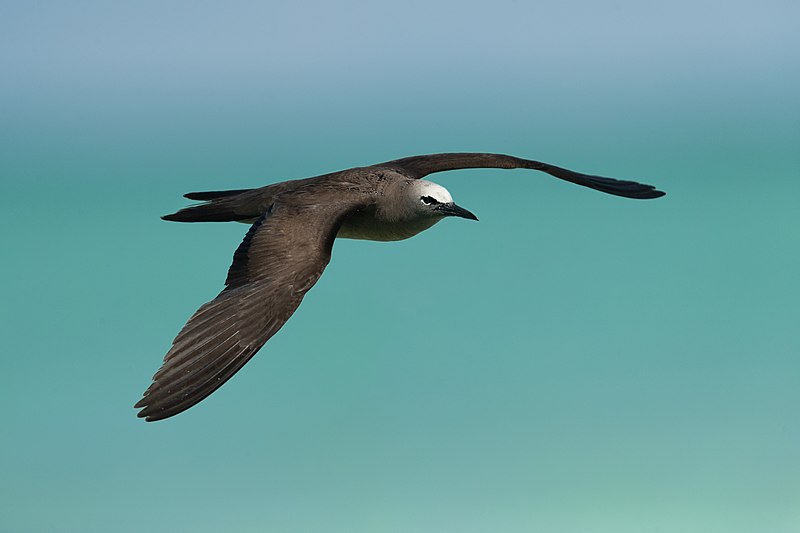
The Brown Noddy (Anous stolidus) is a medium-sized seabird prevalent in tropical oceans globally. It is characterized by its dark chocolate-brown plumage, highlighted by a pale-grey or white crown and forehead.
This species typically nests on cliffs or in trees, producing one egg each breeding season. It forages by skimming the water’s surface for small fish and squid.
Renowned for its buoyant flight, the Brown Noddy is frequently observed in flocks near breeding areas.
Scientific classification:
| Kingdom | Animalia |
| Phylum | Chordata |
| Class | Aves |
| Order | Charadriiformes |
| Family | Laridae |
| Genus | Anous |
| Species | A. stolidus |
Also Featured In: Brown Birds of Florida, Martinique Island Birds You Should Know
35. Fody
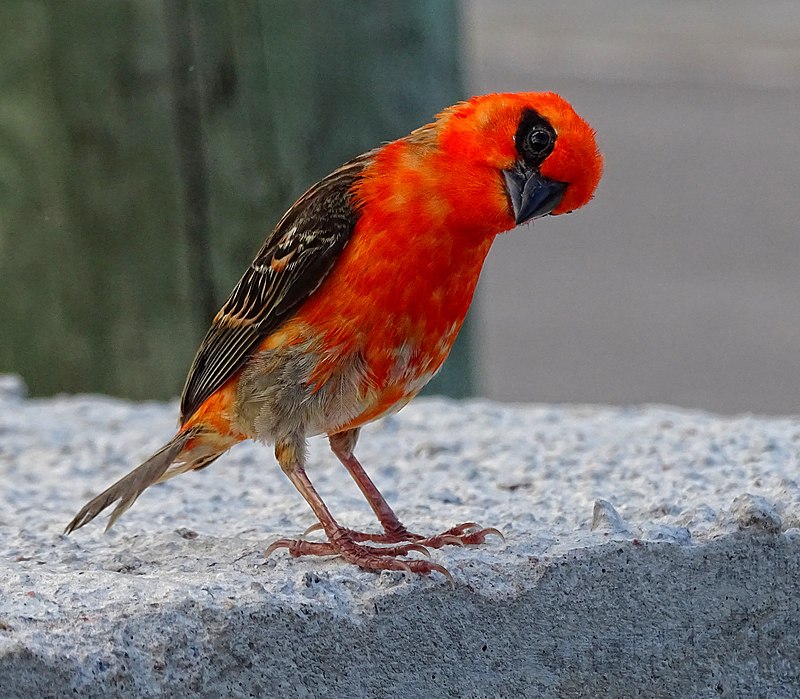
The Fody, part of the weaver family, is a colorful bird found in Mauritius. Typically measuring 12 to 15 cm, these birds have short, conical bills.
Males show red or yellow during breeding, while females resemble sparrows with grey-brown plumage. They adapt to various environments, thriving in forests and woodlands.
Fodies feed on seeds and insects and construct dome-shaped nests, usually hanging from branches.
Scientific classification:
| Kingdom | Animalia |
| Phylum | Chordata |
| Class | Aves |
| Order | Passeriformes |
| Family | Ploceidae |
| Genus | Foudia Reichenbach, 1850 |
36. Mauritius Scops Owl
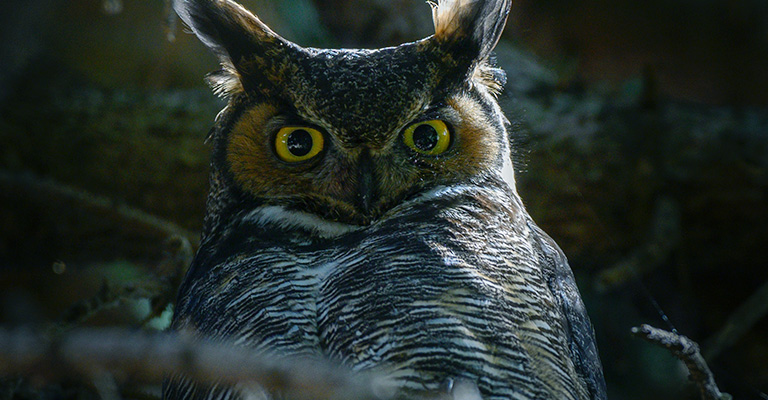
The Mauritius Scops Owl, Otus sauzieri, is a small, nocturnal bird that exclusively inhabits Mauritius.
Measuring 20–25 cm, its appearance is marked by large ear tufts and a rounded body. It primarily hunts insects, small mammals, and birds within forest habitats.
Known for its breeding period from September to December, the owl faces threats from habitat loss. Despite its critically endangered status, ongoing conservation efforts are crucial for preserving its population.
Scientific classification:
| Kingdom | Animalia |
| Phylum | Chordata |
| Class | Aves |
| Order | Strigiformes |
| Family | Strigidae |
| Genus | Otus |
| Species | †O. sauzieri |
37. Newton’s Parakeet
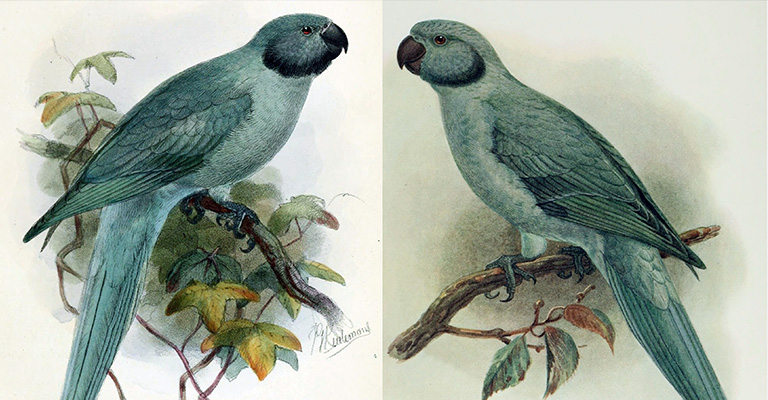
Newton’s Parakeet, also known as the Rodrigues parakeet, is an extinct parrot species native to Rodrigues Island in the Mascarene archipelago.
These birds measured about 40 cm in length and displayed a unique greyish or slate blue plumage.
Males featured distinctive green tinges and a prominent black collar. Related to the rose-ringed parakeet, Newton’s Parakeet faced extinction due to habitat loss and hunting in the 19th century.
Scientific classification:
| Kingdom | Animalia |
| Phylum | Chordata |
| Class | Aves |
| Order | Psittaciformes |
| Family | Psittaculidae |
| Genus | Psittacula |
| Species | †P. exsul |
38. Broad-Billed Roller
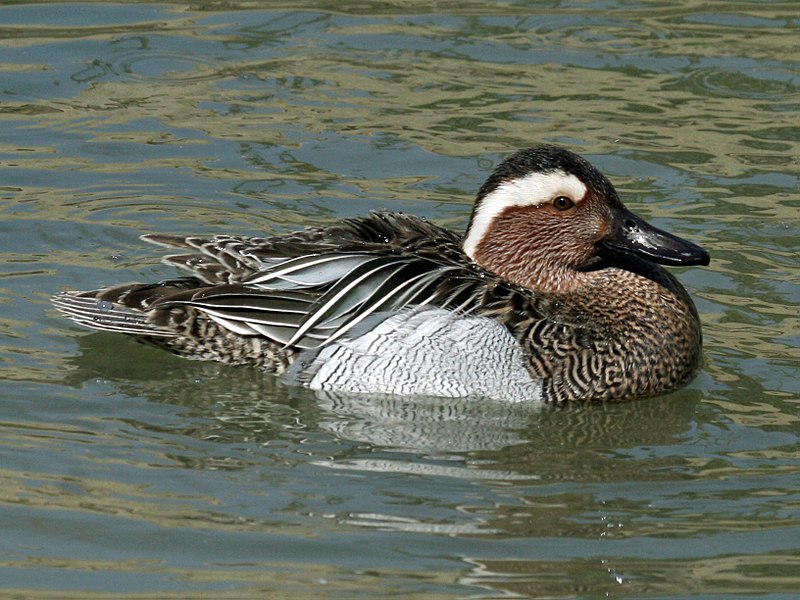
The Broad Billed Roller, Eurystomus glaucurus, thrives in Africa’s open woodlands and riverbanks. This bird measures about 30–32 cm, showcasing hues of blue, green, and brown.
Its broad bill is perfect for catching insects. Often perched on branches, it performs aerial displays and vocalizations.
Nesting occurs in tree cavities with 3-5 eggs laid. Classified as “Least Concern” by IUCN, its population remains stable.
39. Rodrigues Fody
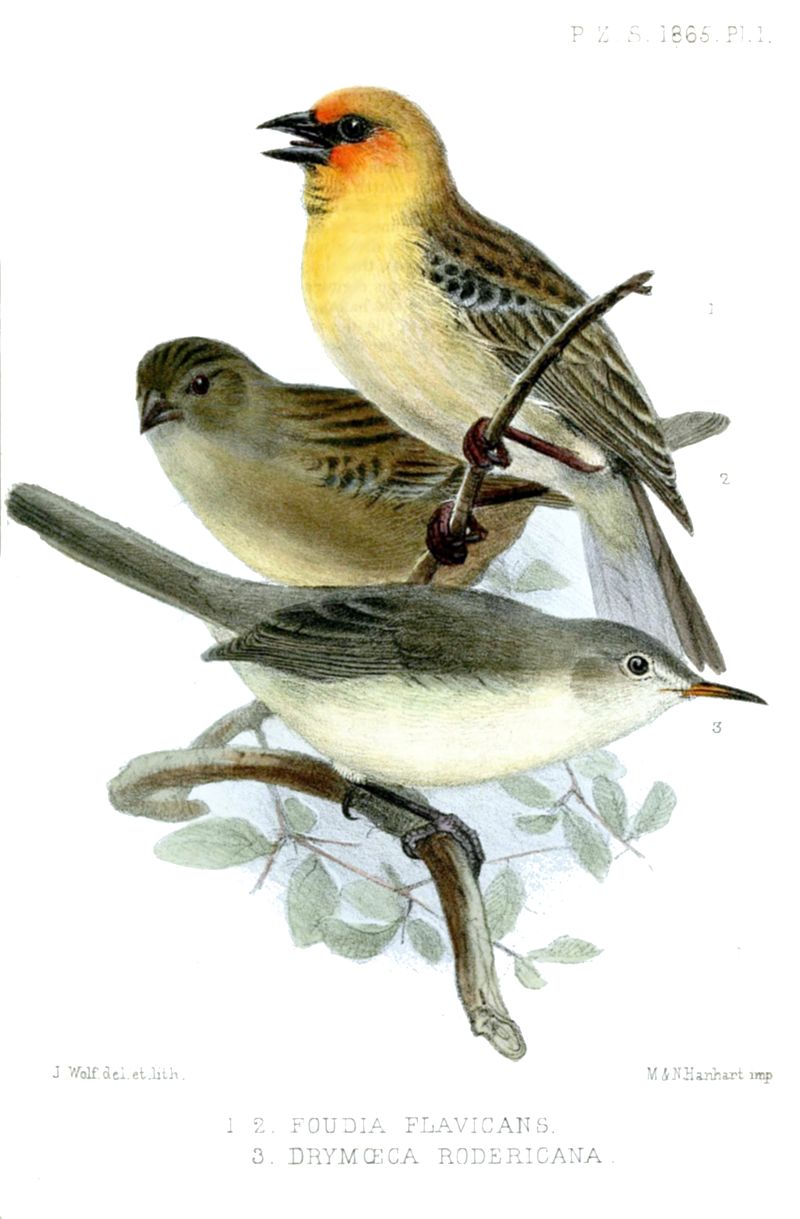
The Rodrigues Fody, or Foudia flavicans, is endemic to Rodrigues Island within the Mauritius archipelago. Measuring about 12 to 13 cm, this rare bird flaunts bright yellow plumage and an orange face.
Habitat destruction led to a drastic population drop to 5-6 pairs in 1968, but conservation efforts boosted numbers to 911-1200 by 1999. It is classified as vulnerable due to ongoing threats from environmental changes.
Scientific classification:
| Kingdom | Animalia |
| Phylum | Chordata |
| Class | Aves |
| Order | Passeriformes |
| Family | Ploceidae |
| Genus | Foudia |
| Species | F. flavicans |
40. White-Eyes Birds
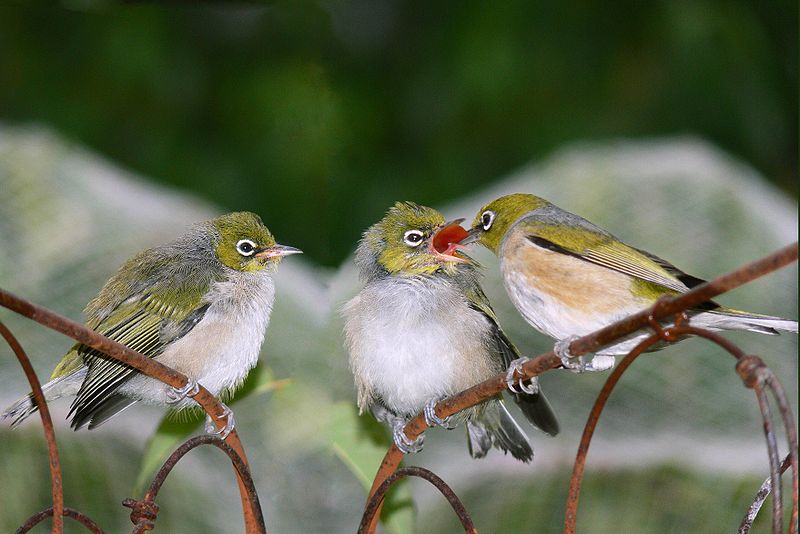
White eyes exhibit distinct white eye rings, a characteristic feature of the Zosteropidae family. These small passerine birds thrive in Mauritius, predominantly residing in forested areas like Black River Gorges National Park.
The Mauritius olive white eye, measuring about 10 cm, is critically endangered, mainly due to habitat loss and invasive species.
Usually, these birds, including the Mauritius gray white eye, showcase greenish olive plumage, contributing to the island’s rich avian diversity.
Scientific classification:
| Kingdom | Animalia |
| Phylum | Chordata |
| Class | Aves |
| Order | Passeriformes |
| Superfamily | Sylvioidea |
| Family | Zosteropidae Bonaparte, 1853 |
41. Pelecaniformes
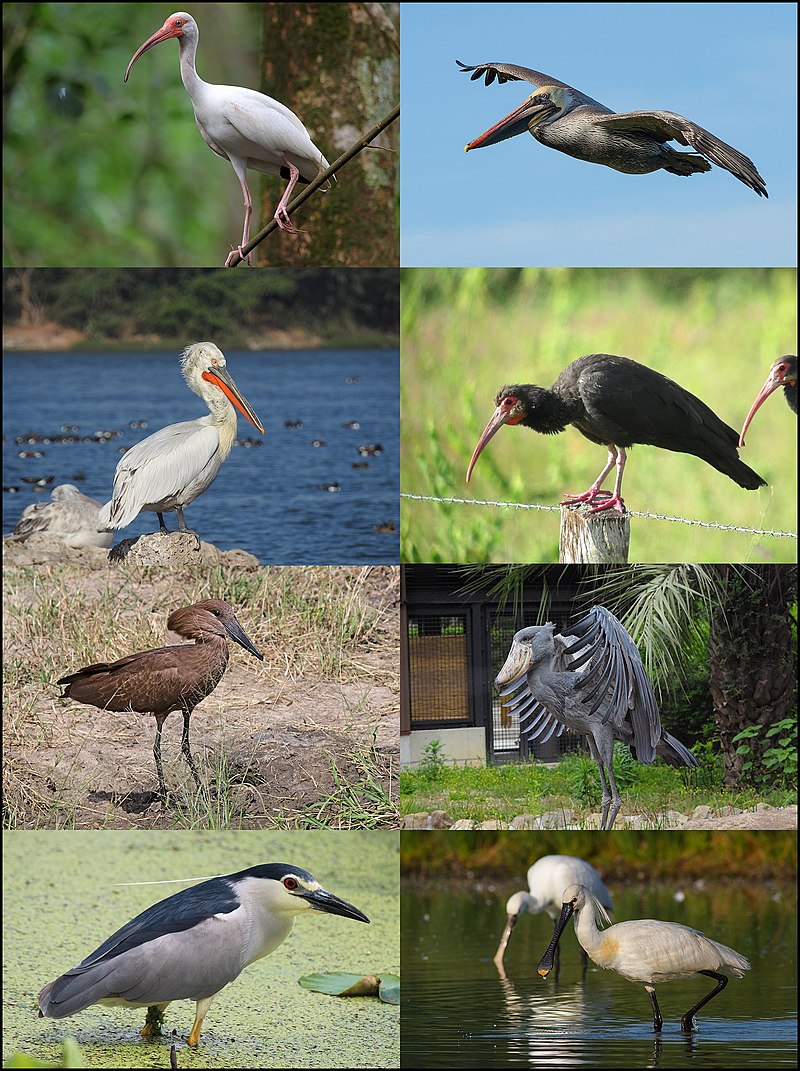
Pelecaniformes consist of medium to large aquatic birds, widespread globally. These birds, with webbed feet, include families such as pelicans and cormorants.
Typically, they possess a gular pouch to catch prey like fish. Their nesting is colonial with monogamous pairs.
Notably, the Ardeidae family falls under this order, featuring herons and egrets which are known residents of Mauritius, thriving in diverse wetland habitats.
Scientific classification:
| Kingdom | Animalia |
| Phylum | Chordata |
| Class | Aves |
| Clade | Aequornithes |
| Order | Pelecaniformes Sharpe, 1891 |
42. Red-Tailed Tropicbird
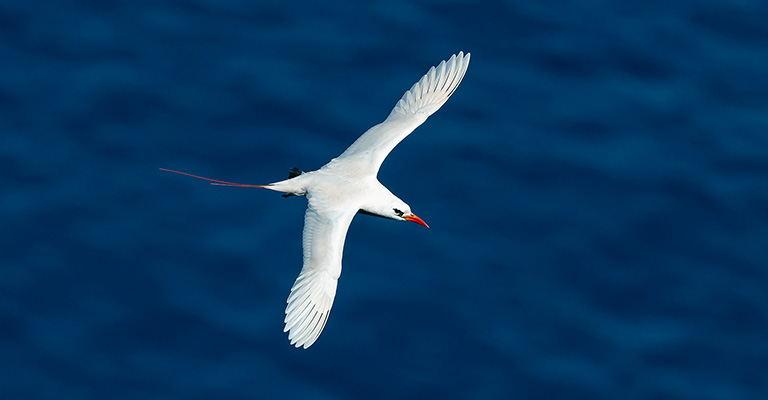
The Red-Tailed Tropicbird, known by its scientific name Phaethon rubricauda, thrives in tropical regions. This seabird showcases distinctive red tail streamers that double its body length.
Measuring 95 to 104 cm, adults weigh about 800 g, significantly larger than the White-Tailed Tropicbird.
Nesting on oceanic islands, they lay a single egg, cared for by both parents over six weeks. Observers can witness their impressive aerial courtship displays.
Scientific classification:
| Kingdom | Animalia |
| Phylum | Chordata |
| Class | Aves |
| Order | Phaethontiformes |
| Family | Phaethontidae |
| Genus | Phaethon |
| Species | P. rubricauda |
Also Featured In: Common Republic of Nauru Birds, Birds that Live in Gold Coasts
43. Red Rail
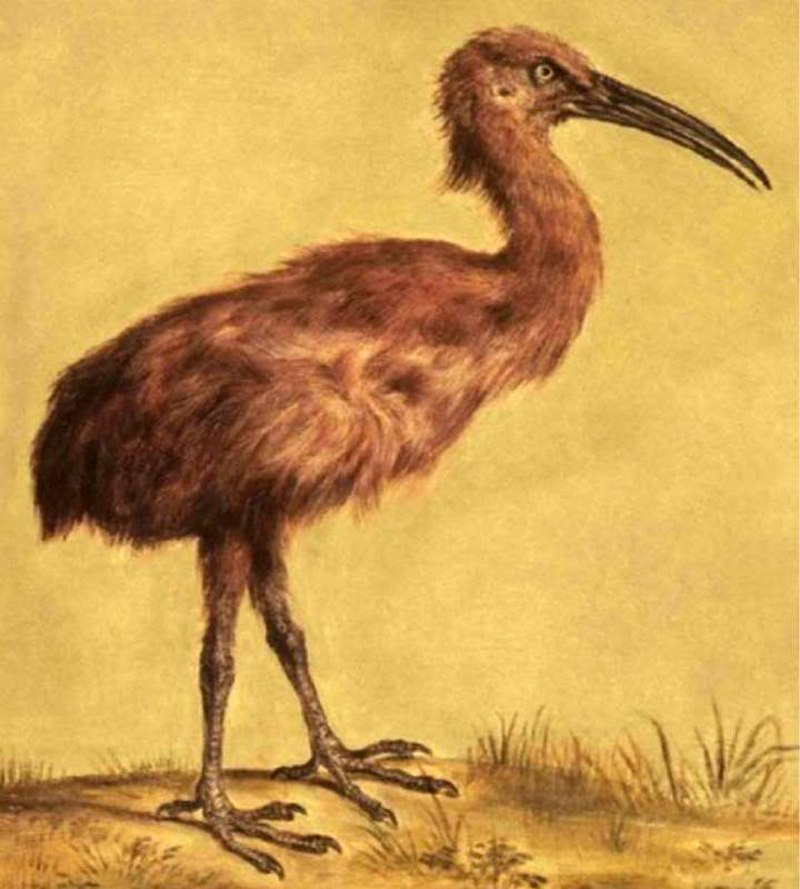
The Red Rail, a flightless bird endemic to Mauritius, became extinct in the late 17th century. Measuring about 35–40 cm, its reddish-brown plumage and long beak stood out.
Small wings limited its ability to fly. It primarily fed on invertebrates and displayed an attraction to red objects. Human hunting and habitat destruction led to its extinction. Subfossil remains have shed light on its unique evolutionary adaptations.
Scientific classification:
| Kingdom | Animalia |
| Phylum | Chordata |
| Class | Aves |
| Order | Gruiformes |
| Family | Rallidae |
| Genus | †Aphanapteryx Frauenfeld, 1868 |
| Species | †A. bonasia |
44. Striated Heron
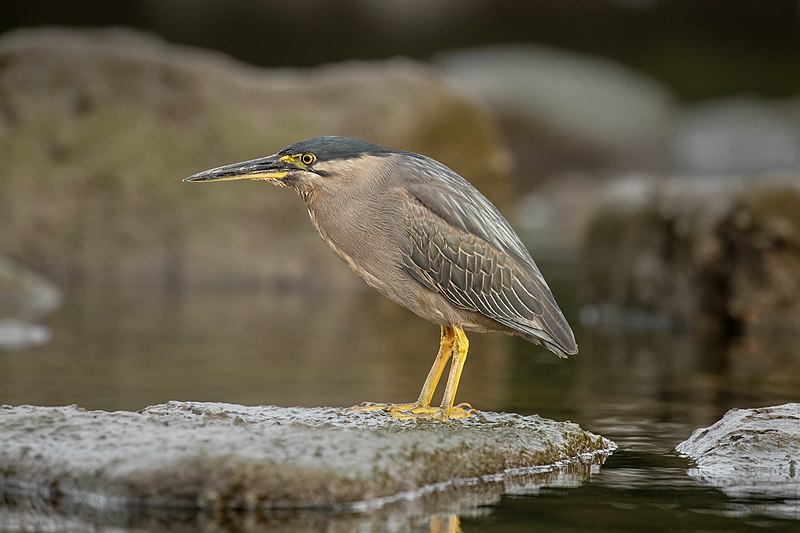
The Striated Heron, known as Butorides striata, stands about 44 cm tall. It features a blue grey back with white underparts.
Found across tropical wetlands from West Africa to Japan, it’s mostly nonmigratory. These herons are skilled ambush predators that feed on small fish and frogs. Their nests, built near water, usually hold two to five pale blue eggs.
Scientific classification:
| Kingdom | Animalia |
| Phylum | Chordata |
| Class | Aves |
| Order | Pelecaniformes |
| Family | Ardeidae |
| Genus | Butorides |
| Species | B. striata |
45. Raphinae
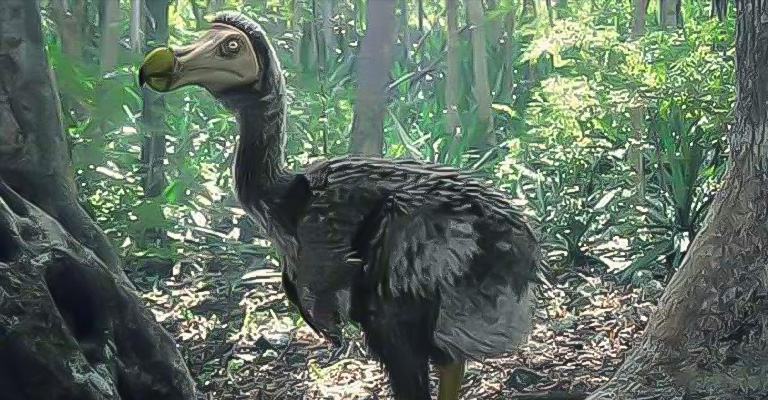
The Raphinae subfamily includes extinct, flightless birds like the dodo and Rodrigues solitaire. Both species were endemic to islands in the Indian Ocean.
Raphinae belonged to the Columbidae family, sharing lineage with modern pigeons and doves. These birds evolved unique traits in predator-free environments.
Sadly, human actions led to their extinction in the 17th century. Hunting and habitat destruction highlighted the vulnerability of island species.
Scientific classification:
| Kingdom | Animalia |
| Phylum | Chordata |
| Class | Aves |
| Order | Columbiformes |
| Family | Columbidae |
| Subfamily | †Raphinae Wetmore, 1930 |
46. Réunion Grey White-Eye
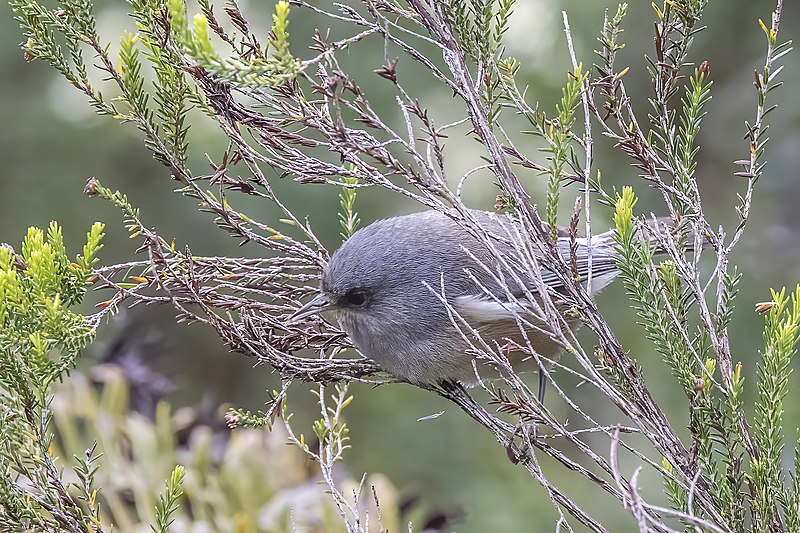
The Réunion Grey White Eye thrives on Réunion Island. Measuring about 12 cm, it’s recognized by a light gray belly and brown sides. Color morphs vary from gray to brown.
This bird, in wooded areas or gardens, feeds on insects and fruits, aiding local orchid pollination. Sociable by nature, it often forms small flocks, nesting in cup-shaped structures with two to four eggs. Though threatened, it remains common on the island.
Scientific classification:
| Kingdom | Animalia |
| Phylum | Chordata |
| Class | Aves |
| Order | Passeriformes |
| Family | Zosteropidae |
| Genus | Zosterops |
| Species | Z. borbonicus |
47. Buttonquail
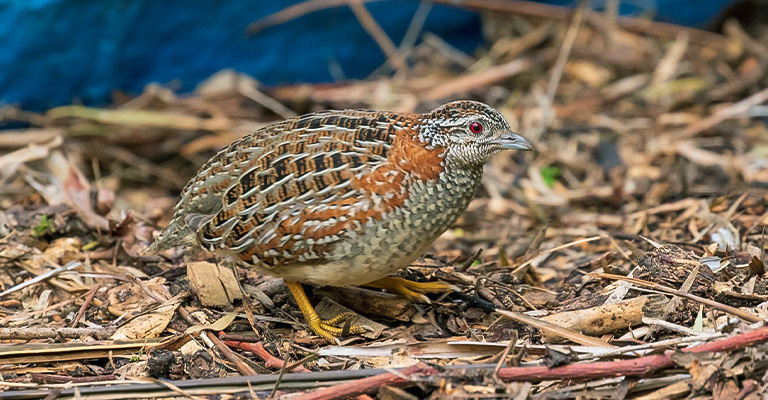
The Buttonquail, part of the Turnicidae family, thrives in warm grasslands across various continents, including parts of Asia and Australia.
They resemble true quails but lack a hind toe. Notably, females exhibit polyandrous behavior, with males incubating the eggs.
Among the species, the common Buttonquail is widespread, yet some subspecies face endangerment due to habitat loss. Conservation efforts focus on mitigating these threats.
Scientific classification:
| Kingdom | Animalia |
| Phylum | Chordata |
| Class | Aves |
| Order | Charadriiformes |
| Family | Turnicidae GR Gray, 1840 |
48. Glareolidae
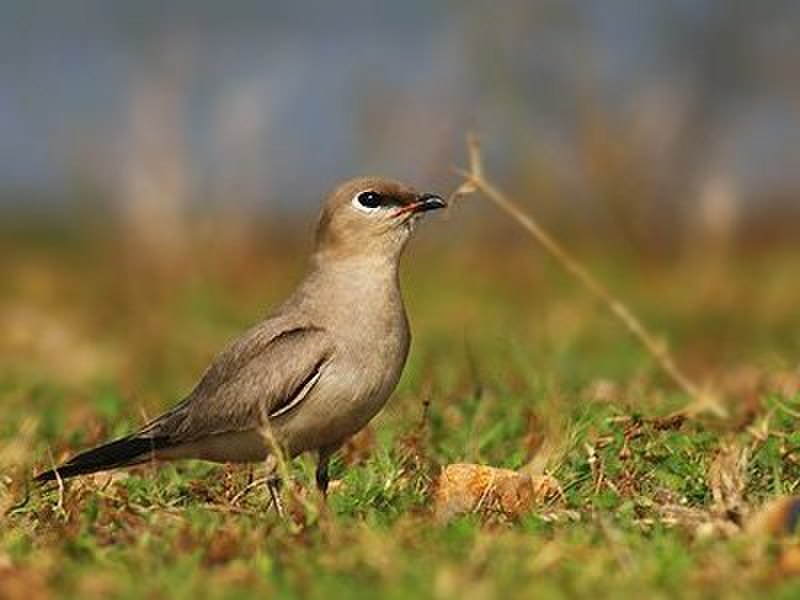
The Glareolidae family includes 17 species such as pratincoles and coursers. Primarily found in open, semi-desert habitats across Africa, Asia, and Australia, they’re recognized for their slender bodies and long wings.
Pratincoles, including the Collared, Oriental, and Madagascar species, feature buoyant flight patterns, catching insects mid-air.
Coursers, though, move terrestrially, foraging using a distinct running-and-stopping technique. Their diet mainly consists of insects.
They exhibit gregarious behavior and often nest in loose colonies. Mauritian bird enthusiasts can explore the unique characteristics of these species.
Scientific classification:
| Kingdom | Animalia |
| Phylum | Chordata |
| Class | Aves |
| Order | Charadriiformes |
| Suborder | Lari |
| Family | Glareolidae CL Brehm, 1831 |
49. Cuckooshrike
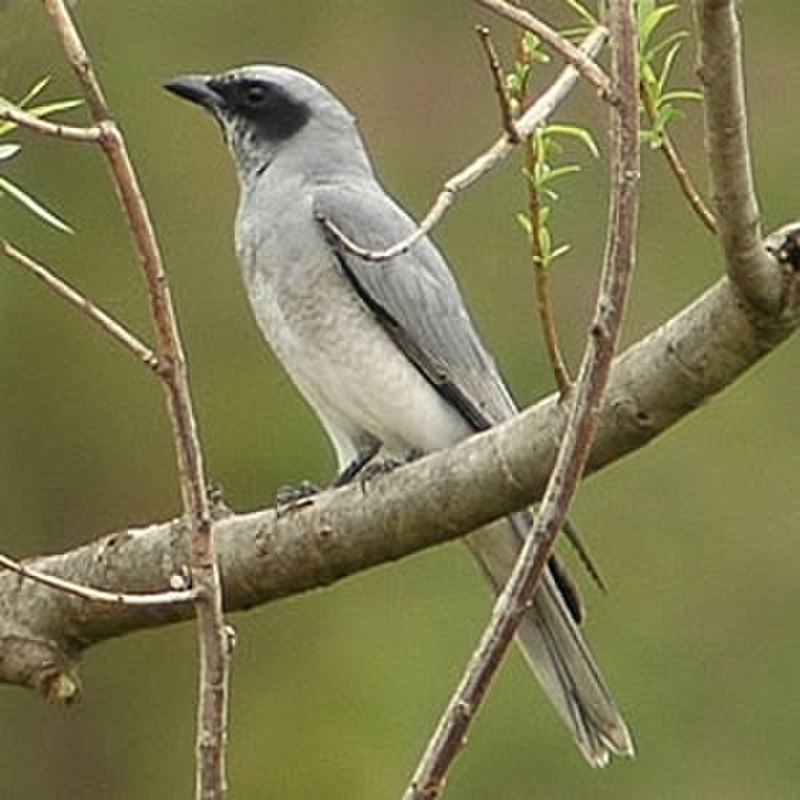
Cuckooshrikes, belonging to the Campephagidae family, thrive in Mauritius. These medium-sized birds feature a striking black and white plumage, along with distinctive yellow eyes.
Thriving predominately in forests, they primarily feed on insects and fruits. Habitat loss and invasive species threaten their existence, but ongoing conservation efforts focus on habitat restoration and protection.
Known for monogamous breeding behaviors, cuckooshrikes exhibit a strong commitment as both parents participate in nest building and chick rearing.
Scientific classification:
| Kingdom | Animalia |
| Phylum | Chordata |
| Class | Aves |
| Order | Passeriformes |
| Infraorder | Corvides |
| Family | Campephagidae Vigors, 1825 |
Top Recap
Mauritius stands as a beacon of avian diversity and conservation success stories. With its rich tapestry of endemic species and the poignant history of the dodo, the island offers a unique glimpse into the intricate dance of nature and human influence.
Conservation efforts have breathed life back into species like the Echo Parakeet and Pink Pigeon, showcasing the resilience of nature when supported by dedicated initiatives.
The Mauritius Kestrel and other rare birds like the Olive White-Eye remind us of the ongoing challenges and triumphs in preserving biodiversity.
As birdwatchers and nature enthusiasts flock to this tropical paradise, the importance of protecting these feathered treasures becomes ever more apparent.
Mauritius not only captivates with its avian life but also serves as a testament to the enduring impact and necessity of conservation efforts worldwide.